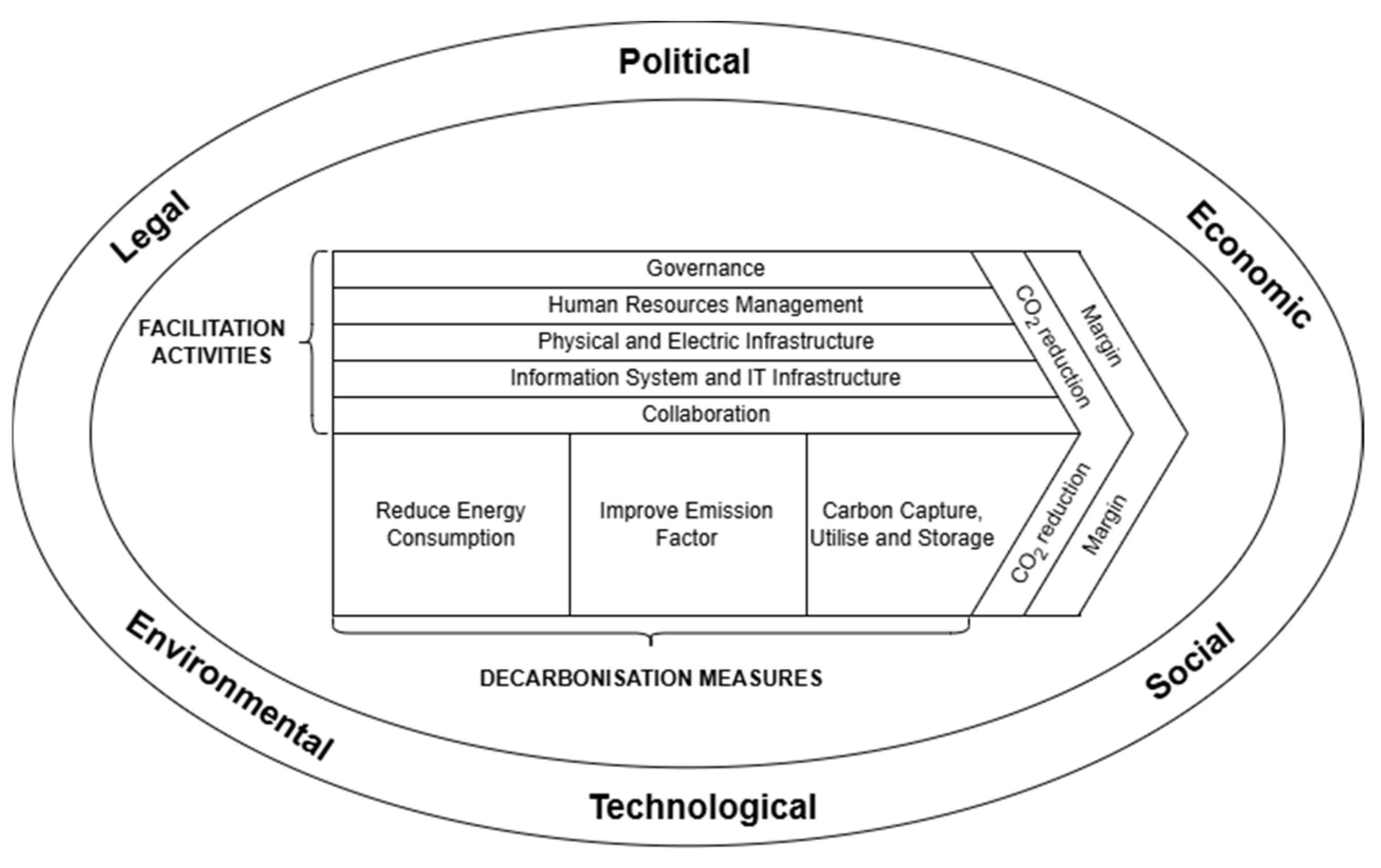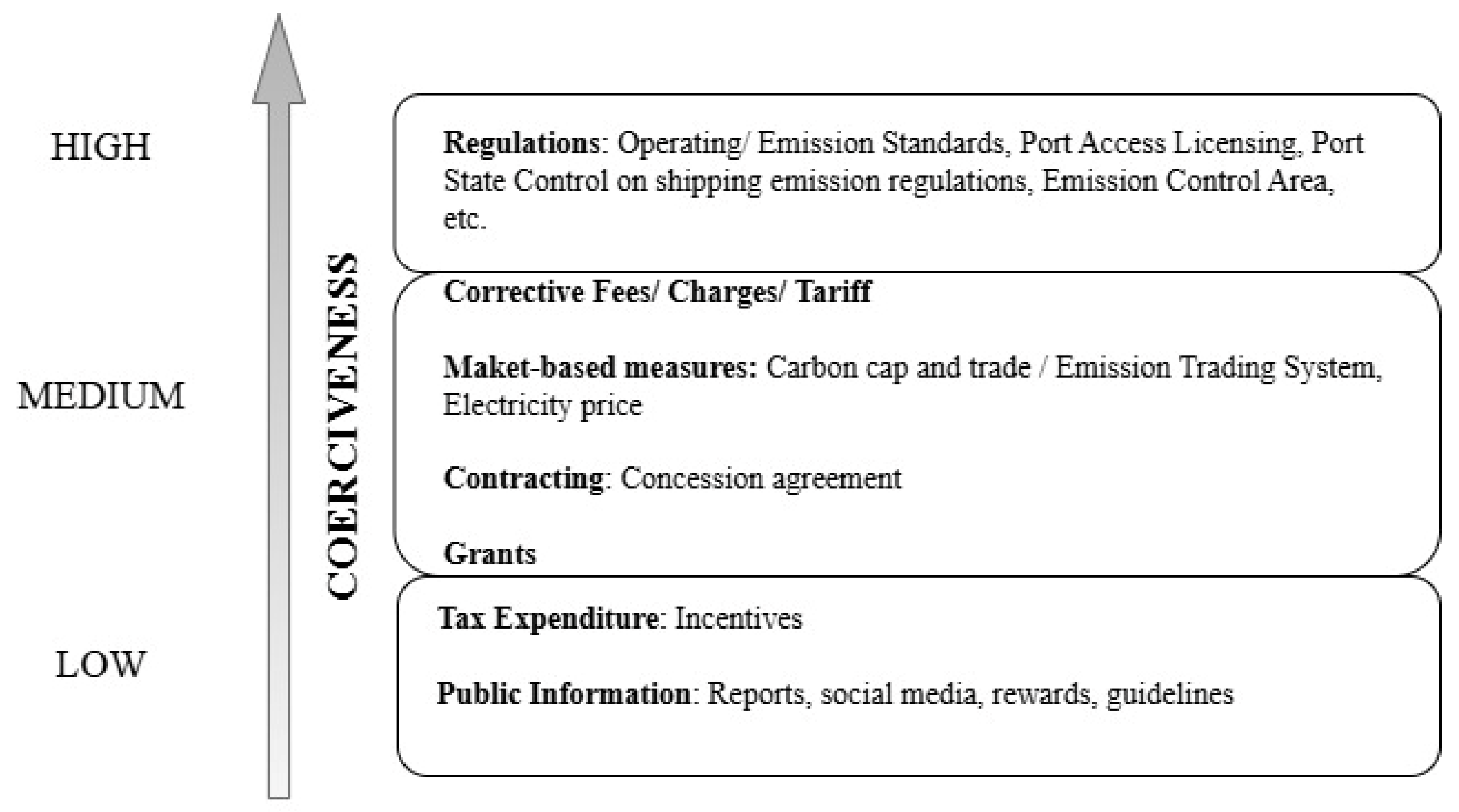Revisiting Port Decarbonization for Advancing a Sustainable Maritime Industry: Insights from Bibliometric Review
Abstract
1. Introduction
2. Foundations of Port Decarbonization
2.1. Definition of Port Decarbonization
2.2. Port Decarbonization Measures
2.3. Port Decarbonization Facilitation Activities
2.4. Port Decarbonization’s Macro-Environment
3. Materials and Methods
3.1. Methods
3.2. Source for Data Analysis
3.3. Search and Data Collection
- Year: Scopus data from the previous year are fully updated by June of the current year. To ensure the reliability of the review, data were limited to the end of 2023;
- Language: English;
- Publication stage: articles in press were excluded;
- Document type: only articles and reviews were included;
- Subject area: all relevant fields within the research scope were considered, including engineering, environmental science, energy, social sciences, computer sciences, mathematics, business, management and accounting, decision sciences, economics, econometrics and finance, and multidisciplinary domains.
- After screening, 3173 documents were excluded.
4. Results and Discussion
4.1. Volume Growth, Geographic Distribution, and Network
4.2. Main Authors
4.3. Key Journals
4.4. Researched Themes
4.5. Research Clusters
4.5.1. PD Measures
4.5.2. PD Facilitation Activities
- (a)
- Governance
- (b)
- Human resources
- (c)
- Physical and electric infrastructure
- (d)
- Information systems and IT infrastructure
- (e)
- Collaboration
4.5.3. Macro-Environment Factors
4.6. Researched Countries
4.7. Researched Methodologies
5. Conclusions
- (1)
- There has been a sharp increase in the PD literature since 2017. To date, this research field has involved 687 authors from 47 countries worldwide. The majority of contributions originate from China, the USA, the United Kingdom, and European countries, along with Taiwan and Australia, while Korea has emerged as a key player. As a result, key authors and research groups are predominantly based in these countries. There are highly cited papers from established research groups, such as those led by Corbett, James J.; Styhre, Linda; and Giuliano, Genevieve. Additionally, there are increasing publications from strong research groups such as Chen, Jihong, Wang, Wengyuan, and Olcer, Aykut. However, international collaboration among researchers remains limited, highlighting the need for greater cooperation between institutions across regions. Furthermore, the metadata of 218 articles spans 86 journal sources. Notably, among the top ten journals, non-maritime journals constitute the majority.
- (2)
- The most dominant keyword over the past decade, “carbon emissions”, is strongly linked to “container terminals”, “cold ironing”, and “green ports”, highlighting that other types of terminals and decarbonization measures remain underexplored. Meanwhile, “emission reduction”, “alternative fuels”, “berth allocation”, “carbon tax”, and “multimodal transport” are emerging topics.
- (3)
- The research clusters are consistently based on the PD’s generic framework, embracing the following:
- PD measures represent the primary research cluster. The five most frequently studied measures include cold ironing, renewable energy, berth and quay crane allocation, vehicle or CHE electrification, and alternative fuels. In contrast, carbon capture and storage have received relatively minimal research attention.
- PD facilitation activities constitute the second-largest research cluster. Within this category, the emission inventory-based strategy takes the highest attention, followed by physical and electronic infrastructure, driven by growing interest in energy management systems. However, research on IT infrastructure and human resource management remains extremely limited.
- The PD macro-environment factor cluster includes articles focusing on legal factors, particularly policies and regulations. Political, economic, social, technological, and environmental factors remain underexplored areas.
- (4)
- The analysis results of researched countries by geographic region and by income reveal that lower-middle-income economies receive minimal attention in PD research.
- (5)
- Current research on port decarbonization (PD) primarily employs quantitative methodologies, often utilizing secondary data or simulations. There is a notable lack of empirical research incorporating qualitative approaches, integrating secondary and primary data, or utilizing mixed methods.
- (1)
- Greater academic attention is required for emerging topics such as “emission reduction”, “alternative fuels”, “berth allocation”, “carbon tax”, and “multimodal transport”.
- (2)
- A broader range of port types should be explored to identify and adopt best practices across bulk, liquid, Ro-Ro, and multipurpose terminals. Given the growing emphasis on multimodal transport, investing in decarbonization strategies for inland waterway terminals is essential.
- (3)
- Decarbonization at ports in lower-middle-income economies across Africa, South America, Oceania, and certain parts of Asia should be examined in consideration of financial and technological resources.
- (4)
- Encouraging collaborative research between authors from developed and developing countries, as well as across different regions, could accelerate decarbonization efforts by fostering knowledge exchange and developing context-specific solutions.
- (5)
- Regarding PD measures, alternative fuels and shore power should be examined within the broader context of green corridor shipping initiatives to ensure alignment with regional and international sustainability efforts. Theoretical lenses such as the diffusion of innovation and the LCA approach should be included in studies of PD measures. Furthermore, a range of energy saving measures, including newly invested measures such as drone-based delivery and carbon capture measures should be prioritized for future research.
- (6)
- In terms of PD facilitation activities, further studies should address the following: (i) physical infrastructure to support the expanding implementation of alternative fuels; (ii) digitalization and IT infrastructure for optimizing port operations; (iii) PD from a governance perspective, including leadership, organizational culture, organizational learning, management strategies, and financial mechanisms, as well as how governance changes across different models and diverse national contexts; (iii) human resource management and necessary curriculum adjustments to effectively implement PD initiatives; (iv) the impact of collaboration on different decarbonization measures, policies, and strategies, as well as its integration with other facilitation activities; (v) green corridors and their broad impacts on local communities, regional planning, environmental sustainability, and economic factors; and (vi) legal frameworks and key drivers of green corridor initiatives and the impacts of restructuring of shipping alliances on global shipping networks and green corridors.
- (7)
- Concerning PD macro-environment factors, future research should investigate the political and social factors influencing PD, and how different political systems shape preferred PD policies. Regarding the legal factors, future studies should focus on policies and legal frameworks that facilitate the following: (i) the adoption and implementation of alternative fuels and renewable energy, (ii) the role of ports as energy hubs for generation, storage, and distribution, and (iii) the use of carbon taxes as a market-based measure to incentivize PD.
- (8)
- Concerning the relationship between three perspectives, further studies could investigate how changes in PD macro-environmental factors influence PD facilitation activities, thereby indirectly advancing PD measures and overall PD achievements.
- (9)
- Relating to methodologies, future empirical studies should consider qualitative methods and primary data to offer a comprehensive understanding of the societal and economic impacts of PD. Additionally, future research should focus on providing actionable insights for policymakers and port operators, using mixed method approaches to develop tailored, scalable solutions, and incorporating advanced tools like machine learning and big data to enhance innovation in decarbonization strategies.
Supplementary Materials
Author Contributions
Funding
Institutional Review Board Statement
Informed Consent Statement
Data Availability Statement
Acknowledgments
Conflicts of Interest
Abbreviations
| GHG | Greenhouse gas |
| LCA | Life Cycle Assessment |
| PA | Paris Agreement |
| PD | Port decarbonization |
Appendix A
| Group | Seaside | Ship–Port Interface | Yard | Port–Land Interface | Administration Facility |
|---|---|---|---|---|---|
| 1. Energy Consumption Reduction/technical | Retrofit existing engines or replace existing engines to have more energy-efficient ones [138] | ||||
| Ships: Hull design, e.g., shape, material, coating [139] Waste heat/energy recovery [140] Energy storage systems [141] Hull cleaning [142] Propeller polishing [143] CHE: Energy-saving tires, CHE tires’ air pressure control [144] Variable Speed Generator for RTG cranes [145] Regenerative power utilization/energy recovery [146] Energy storage systems [147] Engine maintenance [148] Conveyor belt resistance reduction technologies in dry bulk terminals [149] Infrastructure: LED light, cleaning lamps [150] Motion sensors at infrequent human traffic areas [151] Natural ventilation and illumination design, green roof [152] White wall painting, curtains for warehouses and storage [153] Cold storage insulation, reefer sun protection roofs, elastic seals [154] Wall and roof insulation on storage tanks and pipelines in liquid bulk terminals [155] | |||||
| 1. Energy Consumption Reduction (Cont.)/operational | Reducing speed [156] IoT based cargo drone delivery [157] | Pilot scheduling [158] Stowage planning [159] Improving tugboats’ operations [160] Berth booking [161] Virtual arrival/ Just-in-time arrival [162] Automated mooring system [163] Berth allocation planning, quay crane assignment and scheduling [164] Double loading cycles of quay cranes [165] | CHE automatic shut-down and start-up system [166] Vehicle route optimization [167] Yard CHE allocation and scheduling [168] Equipment operation coordination between quayside and yard side [169] Container reshuffling/location optimization [170] Charging station optimization [171] Workforce scheduling [172] Twin-lift or tandem-lift operations in gantry cranes [173] Yard storage management [174] | Truck appointment system [79] Automated gate system [175] Wagon shunting [176] Rail service slot scheduling [177] Chassis exchange terminal/truck sharing [178] Managing truck arrivals with time windows [179] Peak shift [180] Dry ports [181] Off-dock staging yard [182] Container pre-staging [183] | Controlling heating, ventilation, and air conditioning [184] Circular economy to improve recycling [185] Electricity, water, fuel, and paper saving at offices [186] |
| Modal shift to more environmentally friendly modes [181] | |||||
| Energy management systems and technologies (energy storage systems, smart grid, virtual power plants, micro-grids, smart load management: loaf shifting, peak shaving) [187,188,189] | |||||
| Terminal layout [190] | |||||
| Terminal operation system (TOS) [191] | |||||
| Green procurement [192] | |||||
| Automation [193] | |||||
| Digitalization and information sharing system: one-window, electronic data interchange, port community system, vessel traffic management, streamlined ship clearance, standardized documents [194] | |||||
| 2. Improve Emission Factor/technical | Replace fossil fuel-powered engines [138] Use alternative fuel-powered engines (LNG, LPG, biofuel, hydro-treated vegetable oil, methanol, ammonia, hydrogen, e-fuels), fuel cells [195,196] Electrify engines, ideally from renewable energy: wind, solar, geothermal, ocean (waves, tides, salinity, and ocean temperature differences) [197] Use nuclear-powered engines [198] Use hybrid power engines: fuel–electric hybrids, diesel–hydraulic hybrid [199] On-shore power [200] Electric shore-side pumps [201] | ||||
| 3. CCUS/technical | Ship-based carbon capture and storage/mobile CCS [36] | Green buffer zones [202] CCS technologies [37] | |||
Appendix B
| Rank | Territory | Document (s) | Rank | Territory | Document (s) |
|---|---|---|---|---|---|
| 1 | China | 55 | 31 | Thailand | 3 |
| 2 | United States | 16 | 32 | Algeria | 2 |
| 3 | The Netherlands | 15 | 33 | Brazil | 2 |
| 4 | Spain | 14 | 34 | Bulgaria | 2 |
| 5 | Italy | 13 | 35 | Chile | 2 |
| 6 | Sweden | 12 | 36 | Croatia | 2 |
| 7 | United Kingdom | 12 | 37 | Cyprus | 2 |
| 8 | Germany | 11 | 38 | Malta | 2 |
| 9 | Greece | 11 | 39 | Singapore | 2 |
| 10 | Taiwan | 10 | 40 | Slovenia | 2 |
| 11 | Belgium | 9 | 41 | UAE | 2 |
| 12 | Korea | 7 | 42 | Vietnam | 2 |
| 13 | Norway | 6 | 43 | Djibouti | 1 |
| 14 | France | 5 | 44 | Ghana | 1 |
| 15 | Turkey | 5 | 45 | Iceland | 1 |
| 16 | Denmark | 4 | 46 | India | 1 |
| 17 | Finland | 4 | 47 | Lebanon | 1 |
| 18 | Japan | 4 | 48 | Morroco | 1 |
| 19 | Lithuania | 4 | 49 | New Zealand | 1 |
| 20 | Poland | 4 | 50 | Oman | 1 |
| 21 | Australia | 3 | 51 | Philippines | 1 |
| 22 | Canada | 3 | 52 | Russia | 1 |
| 23 | Egypt | 3 | 53 | Saudi Arabia | 1 |
| 24 | Estonia | 3 | 54 | South Africa | 1 |
| 25 | Indonesia | 3 | 55 | Srilanka | 1 |
| 26 | Ireland | 3 | 56 | Europe | 1 |
| 27 | Latvia | 3 | 57 | North Europe | 1 |
| 28 | Malaysia | 3 | |||
| 29 | Portugal | 3 | |||
| 30 | Romania | 3 |
References
- Review of Maritime Transport 2023: Towards a Green and Just Transition; UNCTAD: Geneva, Switzerland, 2023.
- Chen, J.; Zheng, T.; Garg, A.; Xu, L.; Li, S.; Fei, Y. Alternative Maritime Power Application as a Green Port Strategy: Barriers in China. J. Clean. Prod. 2019, 213, 825–837. [Google Scholar] [CrossRef]
- Alamoush, A.S.; Ölçer, A.I.; Ballini, F. Ports’ Role in Shipping Decarbonisation: A Common Port Incentive Scheme for Shipping Greenhouse Gas Emissions Reduction. Clean. Logist. Supply Chain 2022, 3, 100021. [Google Scholar] [CrossRef]
- Resolution MEPC. 323(74), Invitation to Member States to Encourage Voluntary Cooperation Between the Port and Shipping Sectors to Contribute to Reducing GHG Emissions from Ships; Marine Environment Protection Committee: London, UK; IMO: London, UK, 2019. [Google Scholar]
- Notteboom, T.; Pallis, A.; Rodrigue, J.-P. Port Economics, Management and Policy; Routledge: London, UK, 2021. [Google Scholar]
- Iris, Ç.; Lam, J.S.L. A Review of Energy Efficiency in Ports: Operational Strategies, Technologies and Energy Management Systems. Renew. Sustain. Energy Rev. 2019, 112, 170–182. [Google Scholar] [CrossRef]
- Resolution MEPC. 377(80), 2023 IMO Strategy on Reduction of GHG Emission from Ships; IMO: London, UK, 2023. [Google Scholar]
- Burdall, A.C.; Williamson, H.J. A Green Port: An Engineer’s View. In Ports Into the Next Century; Thomas Telford: London, UK, 1991; pp. 247–259. ISBN 0 7277 1619 0. [Google Scholar]
- Couper, A.D. Environmental Port Management. Marit. Policy Manag. 1992, 19, 165–170. [Google Scholar] [CrossRef]
- Sustainable Development for Ports (UNCTAD/SDD/PORT/1); UNCTAD: Geneva, Switzerland, 1993.
- Wu, X.; Zhang, L.; Yang, H.-C. Integration of Eco-Centric Views of Sustainability in Port Planning. Sustainability 2020, 12, 2971. [Google Scholar] [CrossRef]
- Roh, S.; Thai, V.V.; Jang, H.; Yeo, G.-T. The Best Practices of Port Sustainable Development: A Case Study in Korea. Marit. Policy Manag. 2021, 50, 254–280. [Google Scholar] [CrossRef]
- Alamoush, A.S.; Ballini, F.; Ölçer, A.I. Revisiting Port Sustainability as a Foundation for the Implementation of the United Nations Sustainable Development Goals (UN SDGs). J. Shipp. Trade 2021, 6, 19. [Google Scholar] [CrossRef]
- ESPO Green Guide 2021: A Manual for European Ports towards a Green Future; ESPO: Hamamatsu, Shizuoka, 2021.
- Poulsen, R.T.; Ponte, S.; Sornn-Friese, H. Environmental Upgrading in Global Value Chains: The Potential and Limitations of Ports in the Greening of Maritime Transport. Geoforum 2018, 89, 83–95. [Google Scholar] [CrossRef]
- Issa Zadeh, S.B.; Esteban Perez, M.D.; López-Gutiérrez, J.-S.; Fernández-Sánchez, G. Optimizing Smart Energy Infrastructure in Smart Ports: A Systematic Scoping Review of Carbon Footprint Reduction. J. Mar. Sci. Eng. 2023, 11, 1921. [Google Scholar] [CrossRef]
- Issa Zadeh, S.B.; López Gutiérrez, J.S.; Esteban, M.D.; Fernández-Sánchez, G.; Garay-Rondero, C.L. A Framework for Accurate Carbon Footprint Calculation in Seaports: Methodology Proposal. J. Mar. Sci. Eng. 2023, 11, 1007. [Google Scholar] [CrossRef]
- Alzahrani, A.; Petri, I.; Rezgui, Y.; Ghoroghi, A. Decarbonisation of Seaports: A Review and Directions for Future Research. Energy Strategy Rev. 2021, 38, 100727. [Google Scholar] [CrossRef]
- Davarzani, H.; Fahimnia, B.; Bell, M.G.H.; Sarkis, J. Greening Ports and Maritime Logistics: A Review. Transp. Res. Part D Transp. Environ. 2016, 48, 473–487. [Google Scholar] [CrossRef]
- Fadiga, A.; Ferreira, L.M.D.F.; Bigotte, J.F. Decarbonising Maritime Ports: A Systematic Review of the Literature and Insights for New Research Opportunities. J. Clean. Prod. 2024, 452, 142209. [Google Scholar] [CrossRef]
- Lin, C.-Y.; Dai, G.; Wang, S.; Fu, X. The Evolution of Green Port Research: A Knowledge Mapping Analysis. Sustainability 2022, 14, 11857. [Google Scholar] [CrossRef]
- Alamoush, A.S.; Ballini, F.; Ölçer, A.I. Ports’ Technical and Operational Measures to Reduce Greenhouse Gas Emission and Improve Energy Efficiency: A Review. Mar. Pollut. Bull. 2020, 160, 111508. [Google Scholar] [CrossRef]
- Alamoush, A.S.; Ölçer, A.I.; Ballini, F. Port Greenhouse Gas Emission Reduction: Port and Public Authorities’ Implementation Schemes. Res. Transp. Bus. Manag. 2022, 43, 100708. [Google Scholar] [CrossRef]
- Alamoush, A.S. Trends in Port Decarbonisation Research: Are We Reinventing the Wheel? Curr. Opin. Environ. Sustain. 2024, 71, 101478. [Google Scholar] [CrossRef]
- Song, D. A Literature Review of Seaport Decarbonisation: Solution Measures and Roadmap to Net Zero. Sustainability 2024, 16, 1620. [Google Scholar] [CrossRef]
- Sifakis, N.; Tsoutsos, T. Planning Zero-Emissions Ports through the Nearly Zero Energy Port Concept. J. Clean. Prod. 2021, 286, 125448. [Google Scholar] [CrossRef]
- Zadeh, S.B.I.; Gutiérrez, J.S.L.; Esteban, M.D.; Fernández-Sánchez, G.; Garay-Rondero, C.L. Scope of the Literature on Efforts to Reduce the Carbon Footprint of Seaports. Sustainability 2023, 15, 8558. [Google Scholar] [CrossRef]
- Alamoush, A.S.; Dalaklis, D.; Ballini, F.; Ölcer, A.I. Consolidating Port Decarbonisation Implementation: Concept, Pathways, Barriers, Solutions, and Opportunities. Sustainability 2023, 15, 14185. [Google Scholar] [CrossRef]
- UN What Is Offsetting? Available online: https://offset.climateneutralnow.org/aboutoffsetting (accessed on 13 November 2024).
- Lam, J.S.L.; Li, K.X. Green Port Marketing for Sustainable Growth and Development. Transp. Policy 2019, 84, 73–81. [Google Scholar] [CrossRef]
- Johnson, G.; Scholes, K.; Whittington, R. Exploring Corporate Strategy: Text and Cases, 8th ed.; Prentice Hall: Hoboken, NJ, USA, Financial Times: London, UK; 2008. [Google Scholar]
- Porter, M.E. Competitive Advantage: Creating and Sustaining Superior Performance: With a New Introduction; Free Press: New York, NY, USA, 1998. [Google Scholar]
- Carbon Footprinting for Ports: Guidance Document; WPCI: Worcester, MA, USA, 2010.
- Mitsubishi Heavy Industries, Ltd. “CC-OCeAn” Marine-Based CO2 Capture System Demonstration Project Receives “Marine Engineering of the Year 2021” Award. Available online: https://www.mhi.com/news/22072501.html (accessed on 13 November 2024).
- Habibic, A. EverLoNG Wraps up First Carbon Capture Demo Onboard LNG Carrier; 2024. Available online: https://www.offshore-energy.biz/everlong-wraps-up-first-carbon-capture-demo-onboard-lng-carrier/ (accessed on 13 November 2024).
- Tavakoli, S.; Gamlem, G.M.; Kim, D.; Roussanaly, S.; Anantharaman, R.; Yum, K.K.; Valland, A. Exploring the Technical Feasibility of Carbon Capture Onboard Ships. J. Clean. Prod. 2024, 452, 142032. [Google Scholar] [CrossRef]
- Porthos CO2, Transport & Storage Website; Porthos Porthos Project: Rotterdam, The Netherlands, 2024.
- The Maritime Executive Copenhagen Port Participates in Carbon Capture and Storage Project. Available online: https://maritime-executive.com/article/copenhagen-port-participates-in-carbon-capture-and-storage-project (accessed on 13 November 2024).
- Le, S.-T.; Nguyen, T.-H. The Development of Green Ports in Emerging Nations: A Case Study of Vietnam. Sustainability 2023, 15, 13502. [Google Scholar] [CrossRef]
- Puig, M.; Azarkamand, S.; Wooldridge, C.; Selén, V.; Darbra, R.M. Insights on the Environmental Management System of the European Port Sector. Sci. Total Environ. 2022, 806, 150550. [Google Scholar] [CrossRef]
- Christodoulou, A.; Cullinane, K. Identifying the Main Opportunities and Challenges from the Implementation of a Port Energy Management System: A SWOT/PESTLE Analysis. Sustainability 2019, 11, 6046. [Google Scholar] [CrossRef]
- Singh, S.K.; Giudice, M.D.; Chierici, R.; Graziano, D. Green Innovation and Environmental Performance: The Role of Green Transformational Leadership and Green Human Resource Management. Technol. Forecast. Soc. Change 2020, 150, 119762. [Google Scholar] [CrossRef]
- ISO 50001:2018; Energy Management Systems—Requirements with Guidance for Use. ISO: Geneva, Switzerland, 2018.
- Sdoukopoulos, E.; Boile, M.; Tromaras, A.; Anastasiadis, N. Energy Efficiency in European Ports: State-Of-Practice and Insights on the Way Forward. Sustainability 2019, 11, 4952. [Google Scholar] [CrossRef]
- Aregall, M.G.; Bergqvist, R.; Monios, J. A Global Review of the Hinterland Dimension of Green Port Strategies. Transp. Res. Part D Transp. Environ. 2018, 59, 23–34. [Google Scholar] [CrossRef]
- Paulauskas, V.; Filina-Dawidowicz, L.; Paulauskas, D. The Method to Decrease Emissions from Ships in Port Areas. Sustainability 2020, 12, 4374. [Google Scholar] [CrossRef]
- Alamoush, A.S. Harboring Change: Exploring the Multifaceted and Complex Determinants of Decarbonizing Ports. Energy Res. Soc. Sci. 2024, 118, 103751. [Google Scholar] [CrossRef]
- Karimi, S.; Zadeh, M.; Suul, J.A. Shore Charging for Plug-In Battery-Powered Ships: Power System Architecture, Infrastructure, and Control. IEEE Electrif. Mag. 2020, 8, 47–61. [Google Scholar] [CrossRef]
- Wu, X.; Zhang, Y.; Chen, Y. A Dynamic Programming Model for Joint Optimization of Electric Drayage Truck Operations and Charging Stations Planning at Ports. IEEE Trans. Intell. Transport. Syst. 2023, 24, 11710–11719. [Google Scholar] [CrossRef]
- Klopott, M.; Popek, M.; Urbanyi-Popiołek, I. Seaports’ Role in Ensuring the Availability of Alternative Marine Fuels—A Multi-Faceted Analysis. Energies 2023, 16, 3055. [Google Scholar] [CrossRef]
- Parise, G.; Parise, L.; Pepe, F.M.; Ricci, S.; Su, N.C.L.; Chavdarian, P. Innovations in a Container Terminal Area and Electrical Power Distribution for the Service Continuity. In Proceedings of the 2016 IEEE/IAS 52nd Industrial and Commercial Power Systems Technical Conference (I&CPS), Detroit, MI, USA, 1–5 May 2016. [Google Scholar]
- Wehrle, R.; Gast, J.; Wiens, M.; Schultmann, F. On the Influence of Infrastructure Availability on Companies Decisions toward Modal Shift and Relocation of Falicities. Transp. Res. Interdiscip. Perspect. 2023, 19, 100818. [Google Scholar] [CrossRef]
- Clemente, D.; Cabral, T.; Rosa-Santos, P.; Taveira-Pinto, F. Blue Seaports: The Smart, Sustainable and Electrified Ports of the Future. Smart Cities 2023, 6, 1560–1588. [Google Scholar] [CrossRef]
- Bashir, M.O.I. Application Internet of Things (IoT) to Calibrate with IMO 2050 Decarbonization Charters and Phase Out Greenhouse Gases from the Shipping Industry of Bangladesh. In Proceedings of the OCEANS 2022, Chennai, India, 21–24 February 2022; IEEE: Piscatway, NJ, USA, 2022; pp. 1–5. [Google Scholar]
- Eom, J.-O.; Yoon, J.-H.; Yeon, J.-H.; Kim, S.-W. Port Digital Twin Development for Decarbonization: A Case Study Using the PUsAn Newport International Terminal. J. Mar. Sci. Eng. 2023, 11, 1777. [Google Scholar] [CrossRef]
- Teng, Z.; Li, X.; Fang, Y.; Fu, H. Will Port Integration Help Reduce Carbon Emissions and Improve Social Welfare? Discret. Dyn. Nat. Soc. 2021, 2021, 5208046. [Google Scholar] [CrossRef]
- Fenton, P. The Role of Port Cities and Transnational Municipal Networks in Efforts to Reduce Greenhouse Gas Emissions on Land and at Sea from Shipping—An Assessment of the World Ports Climate Initiative. Mar. Policy 2017, 75, 271–277. [Google Scholar] [CrossRef]
- Salamon, L.M. The Tools of Government: A Guide to the New Governance, 1st ed.; Oxford University Press: Oxford, UK, 2002. [Google Scholar]
- Rip, A.; Kemp, R. Technonogical Change. In Human Choice and Climate Change. Volume 2: Resources and Technology; Battelle Press: Columbus, OH, USA, 1998; pp. 327–399. ISBN 1-57477-041-1. [Google Scholar]
- Stephenson, J.R.; Sovacool, B.K.; Inderberg, T.H.J. Energy Cultures and National Decarbonisation Pathways. Renew. Sustain. Energy Rev. 2021, 137, 110592. [Google Scholar] [CrossRef]
- Kuzemko, C.; Lockwood, M.; Mitchell, C.; Hoggett, R. Governing for Sustainable Energy System Change: Politics, Contexts and Contingency. Energy Res. Soc. Sci. 2016, 12, 96–105. [Google Scholar] [CrossRef]
- Lin, B.; Chen, Y. Does Electricity Price Matter for Innovation in Renewable Energy Technologies in China? Energy Econ. 2019, 78, 259–266. [Google Scholar] [CrossRef]
- Lam, J.S.L.; Notteboom, T. The Greening of Ports: A Comparison of Port Management Tools Used by Leading Ports in Asia and Europe. Transp. Rev. 2014, 34, 169–189. [Google Scholar] [CrossRef]
- Donthu, N.; Kumar, S.; Mukherjee, D.; Pandey, N.; Lim, W.M. How to Conduct a Bibliometric Analysis: An Overview and Guidelines. J. Bus. Res. 2021, 133, 285–296. [Google Scholar] [CrossRef]
- Krippendorff, K. Content Analysis: An Introduction to Its Methodology; Sage Publications: New York, NY, USA, 2019. [Google Scholar]
- AlRyalat, S.A.; Malkawi, L.; Momani, S. Comparing Bibliometric Analysis Using PubMed, Scopus, and Web of Science Databases. J. Vis. Exp. 2019, 152, e58494. [Google Scholar] [CrossRef]
- Pranckutė, R. Web of Science (WOS) and Scopus: The Titans of Bibliographic Information in Today’s Academic World. Publications 2021, 9, 12. [Google Scholar] [CrossRef]
- Moher, D.; Liberati, A.; Tetzlaff, J.; Altman, D.G. Preferred Reporting Items for Systematic Reviews and Meta-Analyses: The PRISMA Statement. PLoS Med. 2009, 6, e1000097. [Google Scholar] [CrossRef]
- Alzahrani, A.; Petri, I.; Ghoroughi, A.; Rezgui, Y. A Proposed Roadmap for Delivering Zero Carbon Fishery Ports. Energy Rep. 2022, 8, 82–88. [Google Scholar] [CrossRef]
- Pham, H.-H.; Dong, T.-K.-T.; Vuong, Q.-H.; Luong, D.-H.; Nguyen, T.-T.; Dinh, V.-H.; Ho, M.-T. A Bibliometric Review of Research on International Student Mobilities in Asia with Scopus Dataset between 1984 and 2019. Scientometrics 2021, 126, 5201–5224. [Google Scholar] [CrossRef]
- Livaniou, S.; Chatzistelios, G.; Lyridis, D.V.; Bellos, E. LNG vs. MDO in Marine Fuel Emissions Tracking. Sustainability 2022, 14, 3860. [Google Scholar] [CrossRef]
- Livaniou, S.; Papadopoulos, G.A. Liquefied Natural Gas (LNG) as a Transitional Choice Replacing Marine Conventional Fuels (Heavy Fuel Oil/Marine Diesel Oil), towards the Era of Decarbonisation. Sustainability 2022, 14, 16364. [Google Scholar] [CrossRef]
- Wu, Y.; Chen, A.; Xiao, H.; Jano-Ito, M.; Alnaeli, M.; Alnajideen, M.; Mashruk, S.; Valera-Medina, A. Emission Reduction and Cost-Benefit Analysis of the Use of Ammonia and Green Hydrogen as Fuel for Marine Applications. Green Energy Resour. 2023, 1, 100046. [Google Scholar] [CrossRef]
- Wei, H.; Müller-Casseres, E.; Belchior, C.R.P.; Szklo, A. Evaluating the Readiness of Ships and Ports to Bunker and Use Alternative Fuels: A Case Study from Brazil. J. Mar. Sci. Eng. 2023, 11, 1856. [Google Scholar] [CrossRef]
- Song, J.; Shan, Q.; Zou, T.; Hu, J.; Teng, F. Distributed Energy Management for Zero-Carbon Port Microgrid. Int. Trans. Electr. Energy Syst. 2022, 2022, 2752802. [Google Scholar] [CrossRef]
- Shan, Q.; Song, J.; Xu, Q.; Xiao, G.; Yu, F. Polymorphic Distributed Energy Management for Low-Carbon Port Microgrid With Carbon Capture and Carbon Storage Devices. Front. Energy Res. 2022, 10, 951192. [Google Scholar] [CrossRef]
- Zhang, Y.; Xiao, Y.; Shan, Q.; Li, T. Towards Lower Carbon Emissions: A Distributed Energy Management Strategy-Based Multi-Objective Optimization for the Seaport Integrated Energy System. J. Mar. Sci. Eng. 2023, 11, 681. [Google Scholar] [CrossRef]
- Islam, S.; Olsen, T. Truck-Sharing Challenges for Hinterland Trucking Companies: A Case of the Empty Container Truck Trips Problem. Bus. Process Manag. J. 2014, 20, 290–334. [Google Scholar] [CrossRef]
- Schulte, F.; Lalla-Ruiz, E.; González-Ramírez, R.G.; Voß, S. Reducing Port-Related Empty Truck Emissions: A Mathematical Approach for Truck Appointments with Collaboration. Transp. Res. Part E Logist. Transp. Rev. 2017, 105, 195–212. [Google Scholar] [CrossRef]
- Yıldırım, M.S. Investigating the Impact of Buffer Stacks with Truck Restriction Time Window Policy on Reducing Congestion and Emissions at Port of Izmir. Int. J. Civ. Eng. 2023, 21, 1107–1122. [Google Scholar] [CrossRef]
- Bu, F.; Liu, J.; Liao, H.; Nachtmann, H. An Alternative Solution to Congestion Relief of U.S. Seaports by Container-on-Barge: A Simulation Study. Simul. Model. Pract. Theory 2023, 129, 102836. [Google Scholar] [CrossRef]
- Duong, P.A.; Ryu, B.R.; Song, M.K.; Nguyen, H.V.; Nam, D.; Kang, H. Safety Assessment of the Ammonia Bunkering Process in the Maritime Sector: A Review. Energies 2023, 16, 4019. [Google Scholar] [CrossRef]
- Duong, P.A.; Ryu, B.; Kim, C.; Lee, J.; Kang, H. Energy and Exergy Analysis of an Ammonia Fuel Cell Integrated System for Marine Vessels. Energies 2022, 15, 3331. [Google Scholar] [CrossRef]
- Duong, P.A.; Kim, H.J.; Ryu, B.R.; Kang, H. A Quantitative Risk Analysis during Truck-to-Ship Ammonia Bunkering. Sustainability 2024, 16, 2204. [Google Scholar] [CrossRef]
- Duong, P.A.; Kang, H. Ammonia as Fuel for Marine Dual-Fuel Technology: A Comprehensive Review. Fuel Process. Technol. 2025, 272, 108205. [Google Scholar] [CrossRef]
- Müller, M.; Pfeifer, M.; Holtz, D.; Müller, K. Comparison of Green Ammonia and Green Hydrogen Pathways in Terms of Energy Efficiency. Fuel 2024, 357, 129843. [Google Scholar] [CrossRef]
- Ryu, B.R.; Duong, P.A.; Kang, H. Comparative Analysis of the Thermodynamic Performances of Solid Oxide Fuel Cell–Gas Turbine Integrated Systems for Marine Vessels Using Ammonia and Hydrogen as Fuels. Int. J. Nav. Archit. Ocean Eng. 2023, 15, 100524. [Google Scholar] [CrossRef]
- Duong, P.A.; Ryu, B.R.; Nam, T.T.; Lee, Y.H.; Jung, J.; Lee, J.; Kang, H. Comparative Study of Thermodynamic Performances: Ammonia vs. Methanol SOFC for Marine Vessels. Chem. Eng. Technol. 2024, 47, e202400118. [Google Scholar] [CrossRef]
- Vujicic, A.M.; Zrnić, N.; Jerman, B. Ports Sustainability: A Life Cycle Assessment of Zero Emission Cargo Handling Equipment. Stroj. Vestn.—J. Mech. Eng. 2013, 9, 547–555. [Google Scholar] [CrossRef]
- Tan, Z.; Liu, Q.; Song, J.; Wang, H.; Meng, Q. Ship Choice and Shore-Power Service Assessment for Inland River Container Shipping Networks. Transp. Res. Part D Transp. Environ. 2021, 94, 102805. [Google Scholar] [CrossRef]
- Tan, Z.; Zeng, X.; Wang, T.; Wang, Y.; Chen, J. Capacity Investment of Shore Power Berths for a Container Port: Environmental Incentive and Infrastructure Subsidy Policies. Ocean Coast. Manag. 2023, 239, 106582. [Google Scholar] [CrossRef]
- Peng, Y.; Li, X.; Wang, W.; Wei, Z.; Bing, X.; Song, X. A Method for Determining the Allocation Strategy of On-Shore Power Supply from a Green Container Terminal Perspective. Ocean Coast. Manag. 2019, 167, 158–175. [Google Scholar] [CrossRef]
- Dai, L.; Hu, H.; Wang, Z.; Shi, Y.; Ding, W. An Environmental and Techno-Economic Analysis of Shore Side Electricity. Transp. Res. Part D Transp. Environ. 2019, 75, 223–235. [Google Scholar] [CrossRef]
- Tao, X.; Wu, Q.; Zhu, L. Mitigation Potential of CO2 Emissions from Modal Shift Induced by Subsidy in Hinterland Container Transport. Energy Policy 2017, 101, 265–273. [Google Scholar] [CrossRef]
- Berg, R.V.D.; Langen, P.W.D. An Exploratory Analysis of the Effects of Modal Split Obligations in Terminal Concession Contracts. Int. J. Shipp. Transp. Logist. 2014, 6, 571. [Google Scholar] [CrossRef]
- Peng, Y.; Dong, M.; Li, X.; Liu, H.; Wang, W. Cooperative Optimization of Shore Power Allocation and Berth Allocation: A Balance between Cost and Environmental Benefit. J. Clean. Prod. 2021, 279, 123816. [Google Scholar] [CrossRef]
- Wang, T.; Wang, X.; Meng, Q. Joint Berth Allocation and Quay Crane Assignment under Different Carbon Taxation Policies. Transp. Res. Part B Methodol. 2018, 117, 18–36. [Google Scholar] [CrossRef]
- Corbett, J.J.; Wang, H.; Winebrake, J.J. The Effectiveness and Costs of Speed Reductions on Emissions from International Shipping. Transp. Res. Part D Transp. Environ. 2009, 14, 593–598. [Google Scholar] [CrossRef]
- Odoi-Yorke, F.; Owusu, J.J.; Atepor, L. Composite Decision-Making Algorithms for Optimisation of Hybrid Renewable Energy Systems: Port of Takoradi as a Case Study. Energy Rep. 2022, 8, 2131–2150. [Google Scholar] [CrossRef]
- Kinnon, M.M.; Razeghi, G.; Samuelsen, S. The Role of Fuel Cells in Port Microgrids to Support Sustainable Goods Movement. Renew. Sustain. Energy Rev. 2021, 147, 111226. [Google Scholar] [CrossRef]
- Tang, X.; Xu, C.; Wang, C.; Song, J. A Study on the Influence of Reposition Threshold on Low-Carbon Empty Container Repositioning Strategy under an Uncertain Environment. Front. Mar. Sci. 2023, 10, 1174395. [Google Scholar] [CrossRef]
- Hasan, K.R.; Zhang, W.; Shi, W. A Sustainable Port-Hinterland Container Transport System: The Simulation-Based Scenarios for CO2 Emission Reduction. Sustainability 2023, 15, 9444. [Google Scholar] [CrossRef]
- Okşaş, O. Carbon Emission Strategies for Container Handling Equipment Using the Activity-Based Method: A Case Study of Ambarlı Container Port in Turkiye. Mar. Policy 2023, 149, 105480. [Google Scholar] [CrossRef]
- Kao, S.-L.; Chung, W.-H.; Chen, C.-W. AIS-Based Scenario Simulation for the Control and Improvement of Ship Emissions in Ports. J. Mar. Sci. Eng. 2022, 10, 129. [Google Scholar] [CrossRef]
- Gan, L.; Che, W.; Zhou, M.; Zhou, C.; Zheng, Y.; Zhang, L.; Rangel-Buitrago, N.; Song, L. Ship Exhaust Emission Estimation and Analysis Using Automatic Identification System Data: The West Area of Shenzhen Port, China, as a Case Study. Ocean Coast. Manag. 2022, 226, 106245. [Google Scholar] [CrossRef]
- Styhre, L.; Winnes, H.; Black, J.; Lee, J.; Le-Griffin, H. Greenhouse Gas Emissions from Ships in Ports—Case Studies in Four Continents. Transp. Res. Part D Transp. Environ. 2017, 54, 212–224. [Google Scholar] [CrossRef]
- Mamatok, Y.; Huang, Y.; Jin, C.; Cheng, X. A System Dynamics Model for CO2 Mitigation Strategies at a Container Seaport. Sustainability 2019, 11, 2806. [Google Scholar] [CrossRef]
- Konstantinos, K.; Nikas, A.; Daniil, V.; Kanellou, E.; Doukas, H. A Multi-Criteria Decision Support Framework for Assessing Seaport Sustainability Planning: The Case of Piraeus. Marit. Policy Manag. 2022, 50, 1030–1056. [Google Scholar] [CrossRef]
- Mellin, A.; Rydhed, H. Swedish Ports’ Attitudes towards Regulations of the Shipping Sector’s Emissions of CO2. Marit. Policy Manag. 2011, 38, 437–450. [Google Scholar] [CrossRef]
- Castellano, R.; Ferretti, M.; Musella, G.; Risitano, M. Evaluating the Economic and Environmental Efficiency of Ports: Evidence from Italy. J. Clean. Prod. 2020, 271, 122560. [Google Scholar] [CrossRef]
- Li, Y.; Li, J.; Gong, Y.; Wei, F.; Huang, Q. CO2 Emission Performance Evaluation of Chinese Port Enterprises: A Modified Meta-Frontier Non-Radial Directional Distance Function Approach. Transp. Res. Part D Transp. Environ. 2020, 89, 102605. [Google Scholar] [CrossRef]
- Quintano, C.; Mazzocchi, P.; Rocca, A. Examining Eco-Efficiency in the Port Sector via Non-Radial Data Envelopment Analysis and the Response Based Procedure for Detecting Unit Segments. J. Clean. Prod. 2020, 259, 120979. [Google Scholar] [CrossRef]
- Sornn-Friese, H.; Poulsen, R.T.; Nowinska, A.U.; Langen, P.D. What Drives Ports around the World to Adopt Air Emissions Abatement Measures? Transp. Res. Part D Transp. Environ. 2021, 90, 102644. [Google Scholar] [CrossRef]
- Azarkamand, S.; Balbaa, A.; Wooldridge, C.; Darbra, R.M. Climate Change—Challenges and Response Options for the Port Sector. Sustainability 2020, 12, 6941. [Google Scholar] [CrossRef]
- Li, J.; Liu, X.; Jiang, B. An Exploratory Study on Low-Carbon Ports Development Strategy in China. Asian J. Shipp. Logist. 2011, 27, 91–111. [Google Scholar] [CrossRef]
- Schneider, C.; Lechtenböhmer, S.; Samadi, S. Risks and Opportunities Associated with Decarbonising Rotterdam’s Industrial Cluster. Environ. Innov. Soc. Transit. 2020, 35, 414–428. [Google Scholar] [CrossRef]
- Monios, J.; Wilmsmeier, G.; Tello, G.A.M.; Pomaska, L. A New Conception of Port Governance under Climate Change. J. Transp. Geogr. 2024, 120, 103988. [Google Scholar] [CrossRef]
- Borromeo, G.A. (Ed.) Chapter 14: Shaping the Future of Seafaring in an Age of Safer, Smarter, and Greener Shipping. In Maritime Digitalization and Decarbonization: A Sustainable Future; World Maritime University: Malmö, Sweden, 2025; pp. 180–192. ISBN 978-91-988966-0-2. [Google Scholar]
- Baum-Talmor, P.; Kitada, M. Industry 4.0 in Shipping: Implications to Seafarers’ Skills and Training. Transp. Res. Interdiscip. Perspect. 2022, 13, 100542. [Google Scholar] [CrossRef]
- Belabyad, M.; Kontovas, C.; Pyne, R.; Chang, C.-H. Skills and Competencies for Operating Maritime Autonomous Surface Ships (MASS): A Systematic Review and Bibliometric Analysis. Marit. Policy Manag. 2025, 1–26. [Google Scholar] [CrossRef]
- Sifakis, N.; Konidakis, S.; Tsoutsos, T. Hybrid Renewable Energy System Optimum Design and Smart Dispatch for Nearly Zero Energy Ports. J. Clean. Prod. 2021, 310, 127397. [Google Scholar] [CrossRef]
- Vichos, E.; Sifakis, N.; Tsoutsos, T. Challenges of Integrating Hydrogen Energy Storage Systems into Nearly Zero-Energy Ports. Energy 2022, 241, 122878. [Google Scholar] [CrossRef]
- Misra, A.; Venkataramani, G.; Gowrishankar, S.; Ayyasam, E.; Ramalingam, V. Renewable Energy Based Smart Microgrids—A Pathway To Green Port Development. Strateg. Plan. Energy Environ. 2017, 37, 17–32. [Google Scholar] [CrossRef]
- Cammin, P.; Yu, J.; Heilig, L.; Voß, S. Monitoring of Air Emissions in Maritime Ports. Transp. Res. Part D Transp. Environ. 2020, 87, 102479. [Google Scholar] [CrossRef]
- Cui, H.; Notteboom, T. Modelling Emission Control Taxes in Port Areas and Port Privatization Levels in Port Competition and Co-Operation Sub-Games. Transp. Res. Part D Transp. Environ. 2017, 56, 110–128. [Google Scholar] [CrossRef]
- Homsombat, W.; Yip, T.L.; Yang, H.; Fu, X. Regional Cooperation and Management of Port Pollution. Marit. Policy Manag. 2013, 40, 451–466. [Google Scholar] [CrossRef]
- Damman, S.; Steen, M. A Socio-Technical Perspective on the Scope for Ports to Enable Energy Transition. Transp. Res. Part D Transp. Environ. 2021, 91, 102691. [Google Scholar] [CrossRef]
- Balbaa, A.; Swief, R.A.; El-Amary, N.H. Smart Integration Based on Hybrid Particle Swarm Optimization Technique for Carbon Dioxide Emission Reduction in Eco-Ports. Sustainability 2019, 11, 2218. [Google Scholar] [CrossRef]
- Sarantakos, I.; Bowkett, A.; Allahham, A.; Sayfutdinov, T.; Murphy, A.; Pazouki, K.; Mangan, J.; Liu, G.; Chang, E.; Bougioukou, E.; et al. Digitalization for Port Decarbonization: Decarbonization of Key Energy Processes at the Port of Tyne. IEEE Electrif. Mag. 2023, 11, 61–72. [Google Scholar] [CrossRef]
- Akhavan, M. Decarbonising Maritime Transport: The Role of Green Shipping Corridors in Making Sustainable Port-City Ecosystems. Ocean Soc. 2025, 2, 9411. [Google Scholar] [CrossRef]
- Ismail, A.M.; Ballini, F.; Ölçer, A.I.; Alamoush, A.S. Integrating Ports into Green Shipping Corridors: Drivers, Challenges, and Pathways to Implementation. Mar. Pollut. Bull. 2024, 209, 117201. [Google Scholar] [CrossRef]
- Sheng, D.; Li, Z.-C.; Fu, X.; Gillen, D. Modeling the Effects of Unilateral and Uniform Emission Regulations under Shipping Company and Port Competition. Transp. Res. Part E Logist. Transp. Rev. 2017, 101, 99–114. [Google Scholar] [CrossRef]
- Molavi, A.; Lim, G.J.; Shi, J. Stimulating Sustainable Energy at Maritime Ports by Hybrid Economic Incentives: A Bilevel Optimization Approach. Appl. Energy 2020, 272, 115188. [Google Scholar] [CrossRef]
- Meng, L.; Liu, K.; He, J.; Han, C.; Liu, P. Carbon Emission Reduction Behavior Strategies in the Shipping Industry under Government Regulation: A Tripartite Evolutionary Game Analysis. J. Clean. Prod. 2022, 378, 134556. [Google Scholar] [CrossRef]
- Hashemizadeh, A.; Ju, Y.; Abadi, F.Z.B. Policy Design for Renewable Energy Development Based on Government Support: A System Dynamics Model. Appl. Energy 2024, 376, 124331. [Google Scholar] [CrossRef]
- Jordan, A.; Lorenzoni, I.; Tosun, J.; I Saus, J.E.; Geese, L.; Kenny, J.; Saad, E.L.; Moore, B.; Schaub, S.G. The Political Challenges of Deep Decarbonisation: Towards a More Integrated Agenda. Clim. Action. 2022, 1, 6. [Google Scholar] [CrossRef]
- Dong, N.; Zhu, N.; Li, N.; Wang, N.; Gajpal, N. Evaluating the Environmental Performance and Operational Efficiency of Container Ports: An Application to the Maritime Silk Road. Int. J. Environ. Res. Public Health 2019, 16, 2226. [Google Scholar] [CrossRef]
- Martínez-Moya, J.; Vazquez-Paja, B.; Maldonado, J.A.G. Energy Efficiency and CO2 Emissions of Port Container Terminal Equipment: Evidence from the Port of Valencia. Energy Policy 2019, 131, 312–319. [Google Scholar] [CrossRef]
- Lindstad, H.; Eskeland, G.S. Low Carbon Maritime Transport: How Speed, Size and Slenderness Amounts to Substantial Capital Energy Substitution. Transp. Res. Part D Transp. Environ. 2015, 41, 244–256. [Google Scholar] [CrossRef]
- Baldi, F.; Gabrielii, C. A Feasibility Analysis of Waste Heat Recovery Systems for Marine Applications. Energy 2015, 80, 654–665. [Google Scholar] [CrossRef]
- Hou, J.; Sun, J.; Hofmann, H.F. Mitigating Power Fluctuations in Electric Ship Propulsion With Hybrid Energy Storage System: Design and Analysis. IEEE J. Ocean. Eng. 2018, 43, 93–107. [Google Scholar] [CrossRef]
- Farkas, A.; Degiuli, N.; Martić, I.; Ančić, I. Energy Savings Potential of Hull Cleaning in a Shipping Industry. J. Clean. Prod. 2022, 374, 134000. [Google Scholar] [CrossRef]
- Farkas, A.; Degiuli, N.; Martić, I. The Impact of Biofouling on the Propeller Performance. Ocean Eng. 2021, 219, 108376. [Google Scholar] [CrossRef]
- Wu, W.; Cao, X.; Zou, J.; Ma, Y.; Wu, X.; Sun, C.; Li, M.; Wang, N.; Wang, Z.; Zhang, L. Triboelectric Nanogenerator Boosts Smart Green Tires. Adv. Funct. Mater. 2019, 29, 1806331. [Google Scholar] [CrossRef]
- Bolonne, S.R.A.; Chandima, D.P. Sizing an Energy System for Hybrid Li-Ion Battery-Supercapacitor RTG Cranes Based on State Machine Energy Controller. IEEE Access 2019, 7, 71209–71220. [Google Scholar] [CrossRef]
- Vodovozov, V.; Raud, Z.; Petlenkov, E. Review on Braking Energy Management in Electric Vehicles. Energies 2021, 14, 4477. [Google Scholar] [CrossRef]
- Kermani, M.; Shirdare, E.; Parise, G.; Martirano, L. Integrated System of Energy Storage Technologies for Demand Control and Energy Saving in Ports. In Proceedings of the 2021 IEEE Industry Applications Society Annual Meeting (IAS), Vancouver, BC, Canada, 10 October 2021; IEEE: Piscatway, NJ, USA, 2021; pp. 1–5. [Google Scholar]
- Huang, Y.; Ng, E.C.Y.; Yam, Y.; Lee, C.K.C.; Surawski, N.C.; Mok, W.; Organ, B.; Zhou, J.L.; Chan, E.F.C. Impact of Potential Engine Malfunctions on Fuel Consumption and Gaseous Emissions of a Euro VI Diesel Truck. Energy Convers. Manag. 2019, 184, 521–529. [Google Scholar] [CrossRef]
- He, D.; Pang, Y.; Lodewijks, G.; Liu, X. Healthy Speed Control of Belt Conveyors on Conveying Bulk Materials. Powder Technol. 2018, 327, 408–419. [Google Scholar] [CrossRef]
- Duin, J.H.R.V.; Geerlings, H.; Froese, J.; Negenborn, R.R. Towards a Method for Benchmarking Energy Consumption at Terminals: In Search of Performance Improvement in Yard Lighting. Int. J. Transp. Dev. Integr. 2017, 1, 212–224. [Google Scholar] [CrossRef]
- Delenclos, F.-X.; Rasmussen, A.; Riedl, J. To Get Smart, Ports Go Digital. Available online: https://www.bcg.com/publications/2018/to-get-smart-ports-go-digital (accessed on 13 November 2024).
- Ghaffarianhoseini, A.; Ghaffarianhoseini, A.; Berardi, U.; Tookey, J.; Li, D.H.W.; Kariminia, S. Exploring the Advantages and Challenges of Double-Skin Façades (DSFs). Renew. Sustain. Energy Rev. 2016, 60, 1052–1065. [Google Scholar] [CrossRef]
- Perotti, S.; Coslovich, M.; Granata, E. Transitioning towards Net-Zero Warehouses: Empirical Insights and Best Practices in Italy. In Proceedings of the 2023 9th International Conference on e-Society, e-Learning and e-Technologies, Portsmouth, UK, 9–11 June 2023; ACM: New York, NY, USA, 2023; pp. 82–87. [Google Scholar]
- Filina-Dawidowicz, L.; Filin, S. Innovative Energy-Saving Technology in Refrigerated Containers Transportation. Energy Effic. 2019, 12, 1151–1165. [Google Scholar] [CrossRef]
- Villasmil, W.; Fischer, L.J.; Worlitschek, J. A Review and Evaluation of Thermal Insulation Materials and Methods for Thermal Energy Storage Systems. Renew. Sustain. Energy Rev. 2019, 103, 71–84. [Google Scholar] [CrossRef]
- Lindstad, H.; Asbjørnslett, B.E.; Strømman, A.H. Opportunities for Increased Profit and Reduced Cost and Emissions by Service Differentiation within Container Liner Shipping. Marit. Policy Manag. 2016, 43, 280–294. [Google Scholar] [CrossRef]
- Aerial Drones and Ports: Managing the Risks and Opportunities: A British Ports Association Briefing Paper; British Ports Association: London, UK, 2020.
- Johnson, H.; Styhre, L. Increased Energy Efficiency in Short Sea Shipping through Decreased Time in Port. Transp. Res. Part A Policy Pract. 2015, 71, 167–178. [Google Scholar] [CrossRef]
- Chou, C.-C.; Shiau, W.-S. On Improving Containership Stowage Planning from the Perspective of an Entire Voyage. Marit. Econ. Logist. 2024, 1–27. [Google Scholar] [CrossRef]
- Choi, J.-H.; Jang, J.-Y.; Woo, J. A Review of Autonomous Tugboat Operations for Efficient and Safe Ship Berthing. J. Mar. Sci. Eng. 2023, 11, 1155. [Google Scholar] [CrossRef]
- Mubder, A.A.A.M. The Implementation of Berth Allocation Policies That Enable Just-in-Time Arrival in Port Calls. Int. J. Phys. Distrib. Logist. Manag. 2024, 54, 610–630. [Google Scholar] [CrossRef]
- Andersson, P.; Ivehammar, P. Green Approaches at Sea—The Benefits of Adjusting Speed Instead of Anchoring. Transp. Res. Part D Transp. Environ. 2017, 51, 240–249. [Google Scholar] [CrossRef]
- Díaz-Ruiz-Navamuel, E.; Piris, A.O.; Pérez-Labajos, C.A. Reduction in CO2 Emissions in RoRo/Pax Ports Equipped with Automatic Mooring Systems. Environ. Pollut. 2018, 241, 879–886. [Google Scholar] [CrossRef]
- He, J. Berth Allocation and Quay Crane Assignment in a Container Terminal for the Trade-off between Time-Saving and Energy-Saving. Adv. Eng. Inform. 2016, 30, 390–405. [Google Scholar] [CrossRef]
- Tang, G.; Qin, M.; Zhao, Z.; Yu, J.; Shen, C. Performance of Peak Shaving Policies for Quay Cranes at Container Terminals with Double Cycling. Simul. Model. Pract. Theory 2020, 104, 102129. [Google Scholar] [CrossRef]
- Zhu, R.; Fu, Y.; Wang, L.; Hu, J.; He, L.; Wang, M.; Lai, Y.; Su, S. Effects of a Start-Stop System for Gasoline Direct Injection Vehicles on Fuel Consumption and Particulate Emissions in Hot and Cold Environments. Environ. Pollut. 2022, 308, 119689. [Google Scholar] [CrossRef]
- Tsai, F.-M.; Lu, C.-C.; Chang, Y.-M. A Network Model for Solving the Yard Truck Routing and Scheduling Problem. Int. J. Logist. Manag. 2016, 27, 353–370. [Google Scholar] [CrossRef]
- He, J.; Huang, Y.; Yan, W.; Wang, S. Integrated Internal Truck, Yard Crane and Quay Crane Scheduling in a Container Terminal Considering Energy Consumption. Expert Syst. Appl. 2015, 42, 2464–2487. [Google Scholar] [CrossRef]
- Wang, T.; Li, M.; Hu, H. Berth Allocation and Quay Crane-Yard Truck Assignment Considering Carbon Emissions in Port Area. Int. J. Shipp. Transp. Logist. 2019, 11, 216. [Google Scholar] [CrossRef]
- Tang, L.; Jiang, W.; Liu, J.; Dong, Y. Research into Container Reshuffling and Stacking Problems in Container Terminal Yards. IIE Trans. 2015, 47, 751–766. [Google Scholar] [CrossRef]
- Zhou, G.; Zhu, Z.; Luo, S. Location Optimization of Electric Vehicle Charging Stations: Based on Cost Model and Genetic Algorithm. Energy 2022, 247, 123437. [Google Scholar] [CrossRef]
- Özder, E.H.; Gümüş, M. Solution for the Problem of Sustainable Staff Scheduling in Semi-Automated Dock Container Terminals in Ports. Transp. Res. Rec. J. Transp. Res. Board 2023, 2677, 365–375. [Google Scholar] [CrossRef]
- Huang, S.Y.; Li, Y. Optimization and Evaluation of Tandem Quay Crane Performance. In Proceedings of the 2017 4th International Conference on Systems and Informatics (ICSAI), Hangzhou, China, 11–13 November 2017; IEEE: Piscatway, NJ, USA, 2017; pp. 637–642. [Google Scholar]
- Li, M.-K. Yard Storage Planning for Minimizing Handling Time of Export Containers. Flex. Serv. Manuf. J. 2015, 27, 285–299. [Google Scholar] [CrossRef]
- Chao, S.-L.; Lin, Y.-L. Gate Automation System Evaluation: A Case of a Container Number Recognition System in Port Terminals. Marit. Bus. Rev. 2017, 2, 21–35. [Google Scholar] [CrossRef]
- Krämer, I. Shunt-E 4.0—Autonomous Zero Emission Shunting Processes in Port and Hinterland Railway Operations. J. Traffic Transp. Eng. 2019, 7, 157–164. [Google Scholar] [CrossRef]
- Zhang, X.; Li, L.; Zhang, J. An Optimal Service Model for Rail Freight Transportation: Pricing, Planning, and Emission Reducing. J. Clean. Prod. 2019, 218, 565–574. [Google Scholar] [CrossRef]
- Phan, M.-H.; Kim, K.H. Collaborative Truck Scheduling and Appointments for Trucking Companies and Container Terminals. Transp. Res. Part B Methodol. 2016, 86, 37–50. [Google Scholar] [CrossRef]
- Chen, G.; Jiang, L. Managing Customer Arrivals with Time Windows: A Case of Truck Arrivals at a Congested Container Terminal. Ann. Oper. Res. 2016, 244, 349–365. [Google Scholar] [CrossRef]
- Bentolila, D.J.; Ziedenveber, R.K.; Hayuth, Y.; Notteboom, T. Off-Peak Truck Deliveries at Container Terminals: The “Good Night” Program in Israel. Marit. Bus. Rev. 2016, 1, 2–20. [Google Scholar] [CrossRef]
- Tsao, Y.-C.; Linh, V.T. Seaport- Dry Port Network Design Considering Multimodal Transport and Carbon Emissions. J. Clean. Prod. 2018, 199, 481–492. [Google Scholar] [CrossRef]
- Zhou, Y.; Wang, W.; Song, X.; Guo, Z. Simulation-Based Optimization for Yard Design at Mega Container Terminal under Uncertainty. Math. Probl. Eng. 2016, 2016, 7467498. [Google Scholar] [CrossRef]
- Xie, Y.; Song, D.-P. Optimal Planning for Container Prestaging, Discharging, and Loading Processes at Seaport Rail Terminals with Uncertainty. Transp. Res. Part E Logist. Transp. Rev. 2018, 119, 88–109. [Google Scholar] [CrossRef]
- Taheri, S.; Hosseini, P.; Razban, A. Model Predictive Control of Heating, Ventilation, and Air Conditioning (HVAC) Systems: A State-of-the-Art Review. J. Build. Eng. 2022, 60, 105067. [Google Scholar] [CrossRef]
- Carpenter, A.; Lozano, R.; Sammalisto, K.; Astner, L. Securing a Port’s Future through Circular Economy: Experiences from the Port of Gävle in Contributing to Sustainability. Mar. Pollut. Bull. 2018, 128, 539–547. [Google Scholar] [CrossRef]
- Andor, M.A.; Fels, K.M. Behavioral Economics and Energy Conservation—A Systematic Review of Non-Price Interventions and Their Causal Effects. Ecol. Econ. 2018, 148, 178–210. [Google Scholar] [CrossRef]
- Ahamad, N.B.B.; Guerrero, J.M.; Su, C.-L.; Vasquez, J.C.; Zhaoxia, X. Microgrids Technologies in Future Seaports. In Proceedings of the 2018 IEEE International Conference on Environment and Electrical Engineering and 2018 IEEE Industrial and Commercial Power Systems Europe (EEEIC/I&CPS Europe), Palermo, Italy, 12–15 June 2018; IEEE: Piscatway, NJ, USA, 2018; pp. 1–6. [Google Scholar]
- Kanellos, F.D. Multiagent-System-Based Operation Scheduling of Large Ports’ Power Systems With Emissions Limitation. IEEE Syst. J. 2019, 13, 1831–1840. [Google Scholar] [CrossRef]
- Parise, G.; Parise, L.; Malerba, A.; Pepe, F.M.; Honorati, A.; Chavdarian, P.B. Comprehensive Peak-Shaving Solutions for Port Cranes. IEEE Trans. Ind. Applicat. 2017, 53, 1799–1806. [Google Scholar] [CrossRef]
- Budiyanto, M.A.; Huzaifi, M.H.; Sirait, S.J.; Prayoga, P.H.N. Evaluation of CO2 Emissions and Energy Use with Different Container Terminal Layouts. Sci. Rep. 2021, 11, 5476. [Google Scholar] [CrossRef] [PubMed]
- Hervás-Peralta, M.; Poveda-Reyes, S.; Molero, G.D.; Santarremigia, F.E.; Pastor-Ferrando, J.-P. Improving the Performance of Dry and Maritime Ports by Increasing Knowledge about the Most Relevant Functionalities of the Terminal Operating System (TOS). Sustainability 2019, 11, 1648. [Google Scholar] [CrossRef]
- MacNeil, J.L.; Adams, M.; Walker, T.R. Development of Framework for Improved Sustainability in the Canadian Port Sector. Sustainability 2021, 13, 11980. [Google Scholar] [CrossRef]
- Bechtsis, D.; Tsolakis, N.; Vlachos, D.; Iakovou, E. Sustainable Supply Chain Management in the Digitalisation Era: The Impact of Automated Guided Vehicles. J. Clean. Prod. 2017, 142, 3970–3984. [Google Scholar] [CrossRef]
- Zhang, Z.; Song, C.; Zhang, J.; Chen, Z.; Liu, M.; Aziz, F.; Kurniawan, T.A.; Yap, P.-S. Digitalization and Innovation in Green Ports: A Review of Current Issues, Contributions and the Way Forward in Promoting Sustainable Ports and Maritime Logistics. Sci. Total Environ. 2024, 912, 169075. [Google Scholar] [CrossRef]
- Yun, P.E.N.G.; Xiangda, L.I.; Wenyuan, W.A.N.G.; Ke, L.I.U.; Chuan, L.I. A Simulation-Based Research on Carbon Emission Mitigation Strategies for Green Container Terminals. Ocean Eng. 2018, 163, 288–298. [Google Scholar] [CrossRef]
- Bicer, Y.; Dincer, I. Clean Fuel Options with Hydrogen for Sea Transportation: A Life Cycle Approach. Int. J. Hydrogen Energy 2018, 43, 1179–1193. [Google Scholar] [CrossRef]
- Jonathan, Y.C.E.; Kader, S.B.A. Prospect of Emission Reduction Standard for Sustainable Port Equipment Electrification. Int. J. Eng. 2018, 31, 1347–1355. [Google Scholar] [CrossRef]
- Bhattacharyya, R.; El-Emam, R.S.; Khalid, F. Climate Action for the Shipping Industry: Some Perspectives on the Role of Nuclear Power in Maritime Decarbonization. e-Prime-Adv. Electr. Eng. Electron. Energy 2023, 4, 100132. [Google Scholar] [CrossRef]
- Wei, H.; Wei, G.; Jian-Xin, C. The Dynamic Power Control Technology for the High Power Lithium Battery Hybrid Rubber-Tired Gantry (RTG) Crane. IEEE Trans. Ind. Electron. 2019, 66, 132–140. [Google Scholar] [CrossRef]
- Innes, A.; Monios, J. Identifying the Unique Challenges of Installing Cold Ironing at Small and Medium Ports—The Case of Aberdeen. Transp. Res. Part D Transp. Environ. 2018, 62, 298–313. [Google Scholar] [CrossRef]
- Kanchiralla, F.M.; Brynolf, S.; Oliveira, D.S.R.D. Heat Pump as an Emission Reduction Measure for Ships: Environmental and Economic Assessment. Moses 2024. [Google Scholar] [CrossRef]
- Hua, C.; Chen, J.; Wan, Z.; Xu, L.; Bai, Y.; Zheng, T.; Fei, Y. Evaluation and Governance of Green Development Practice of Port: A Sea Port Case of China. J. Clean. Prod. 2020, 249, 119434. [Google Scholar] [CrossRef]

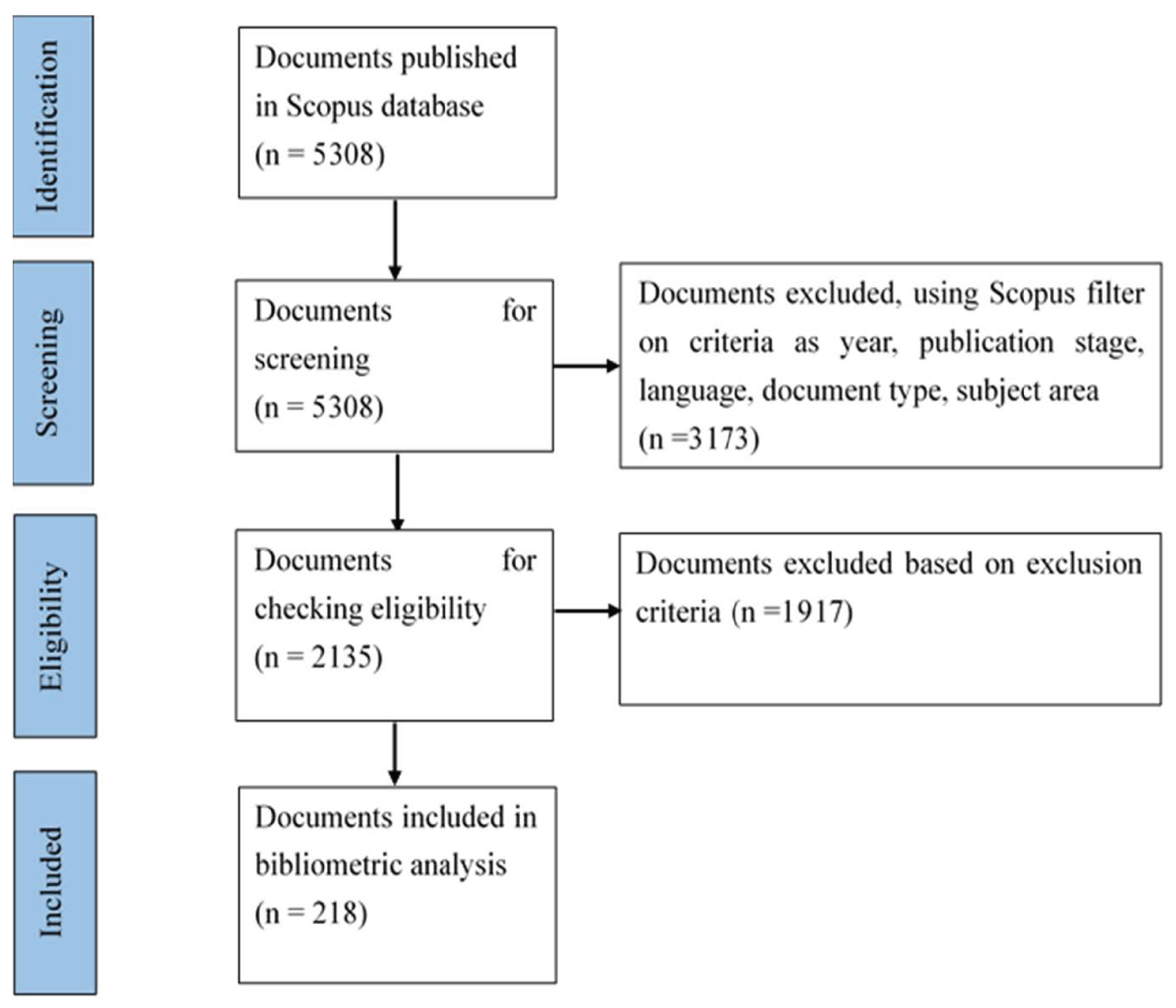


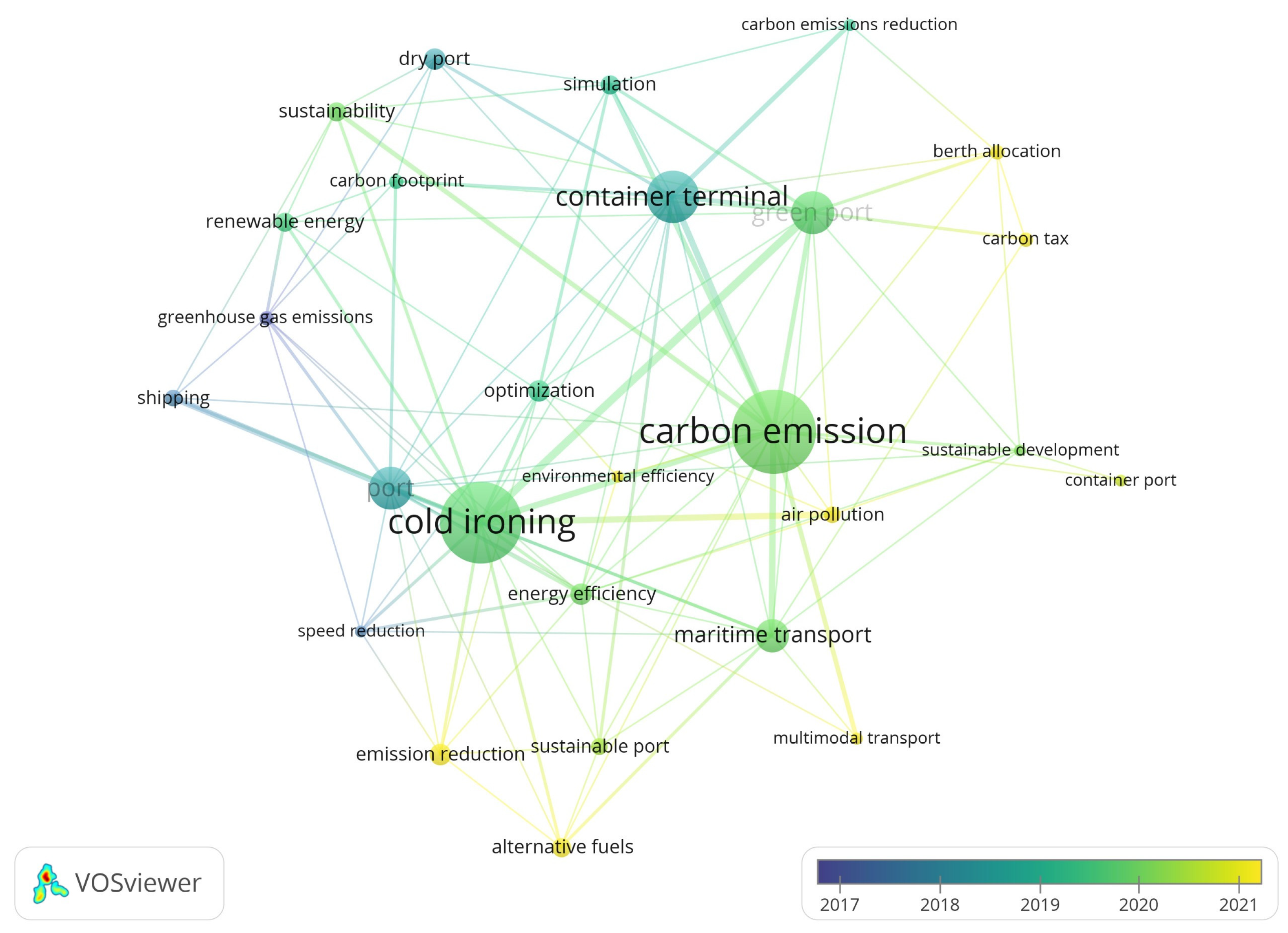
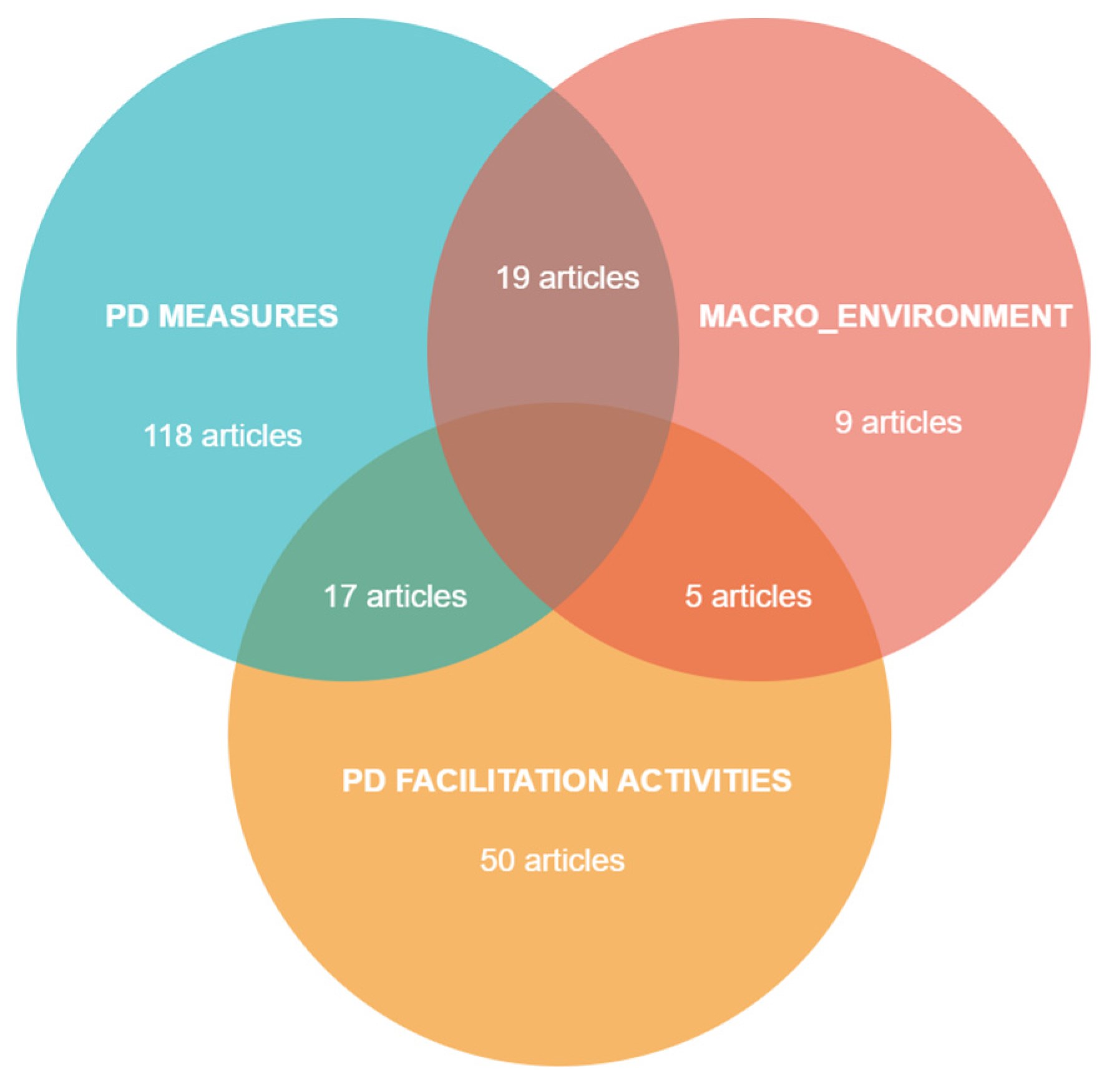
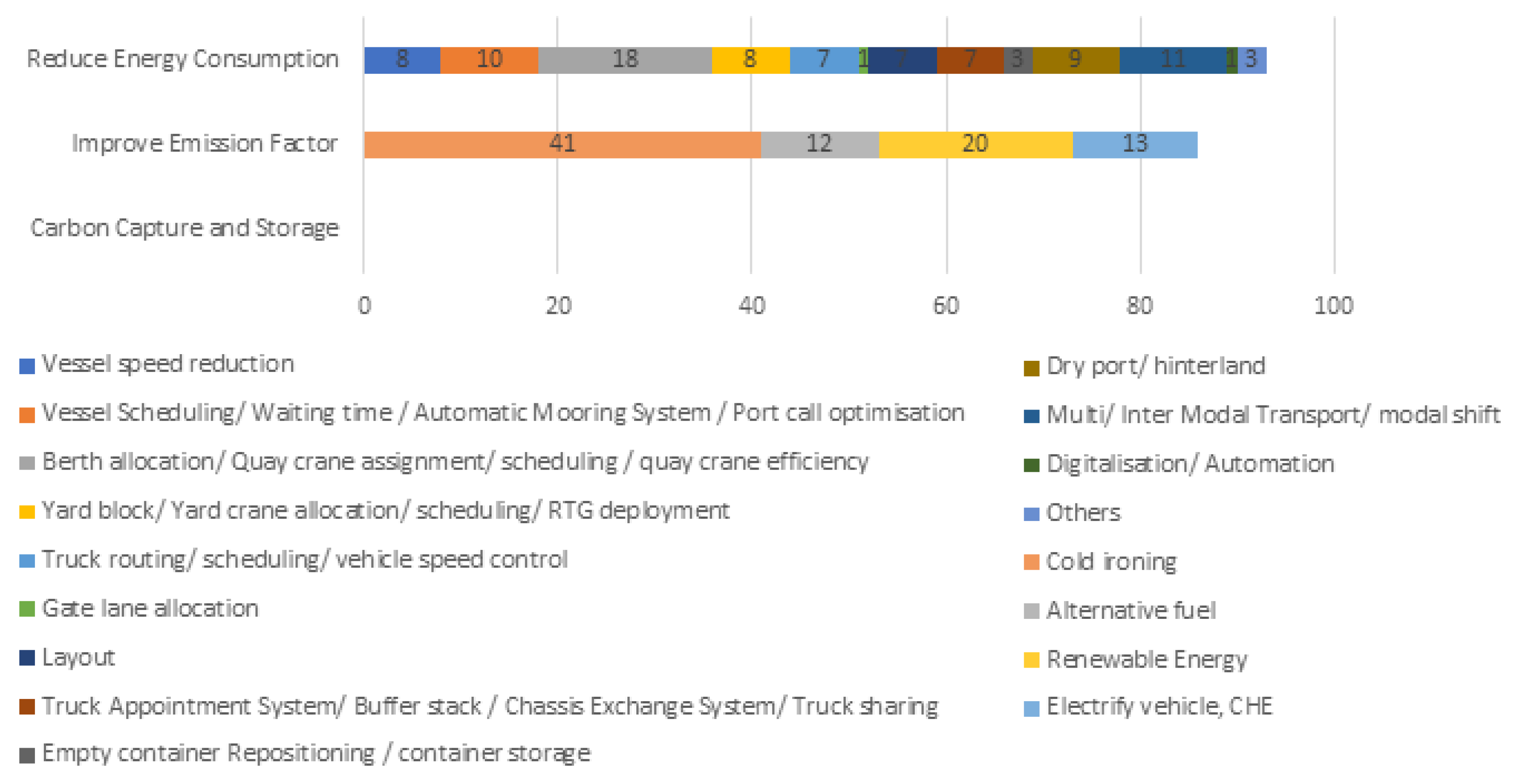
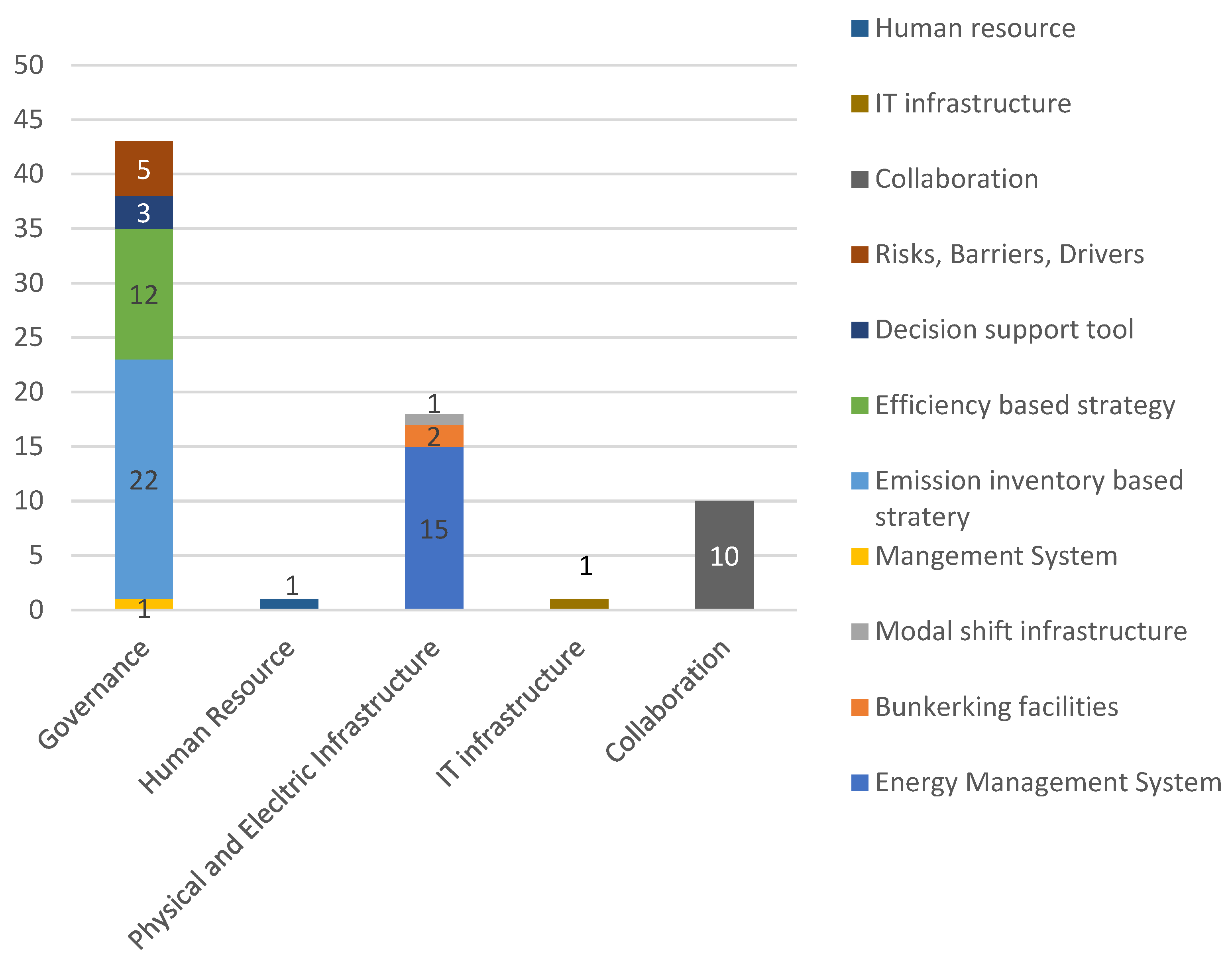
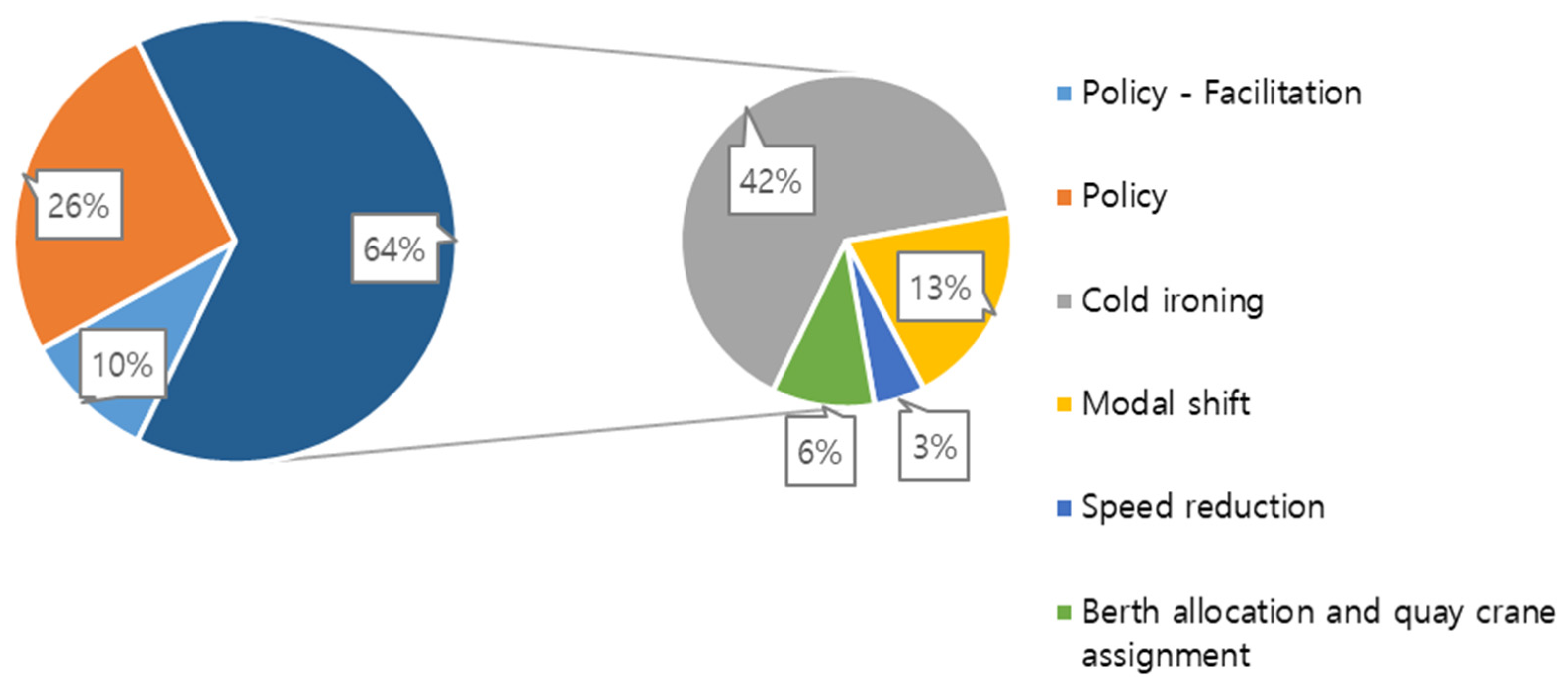
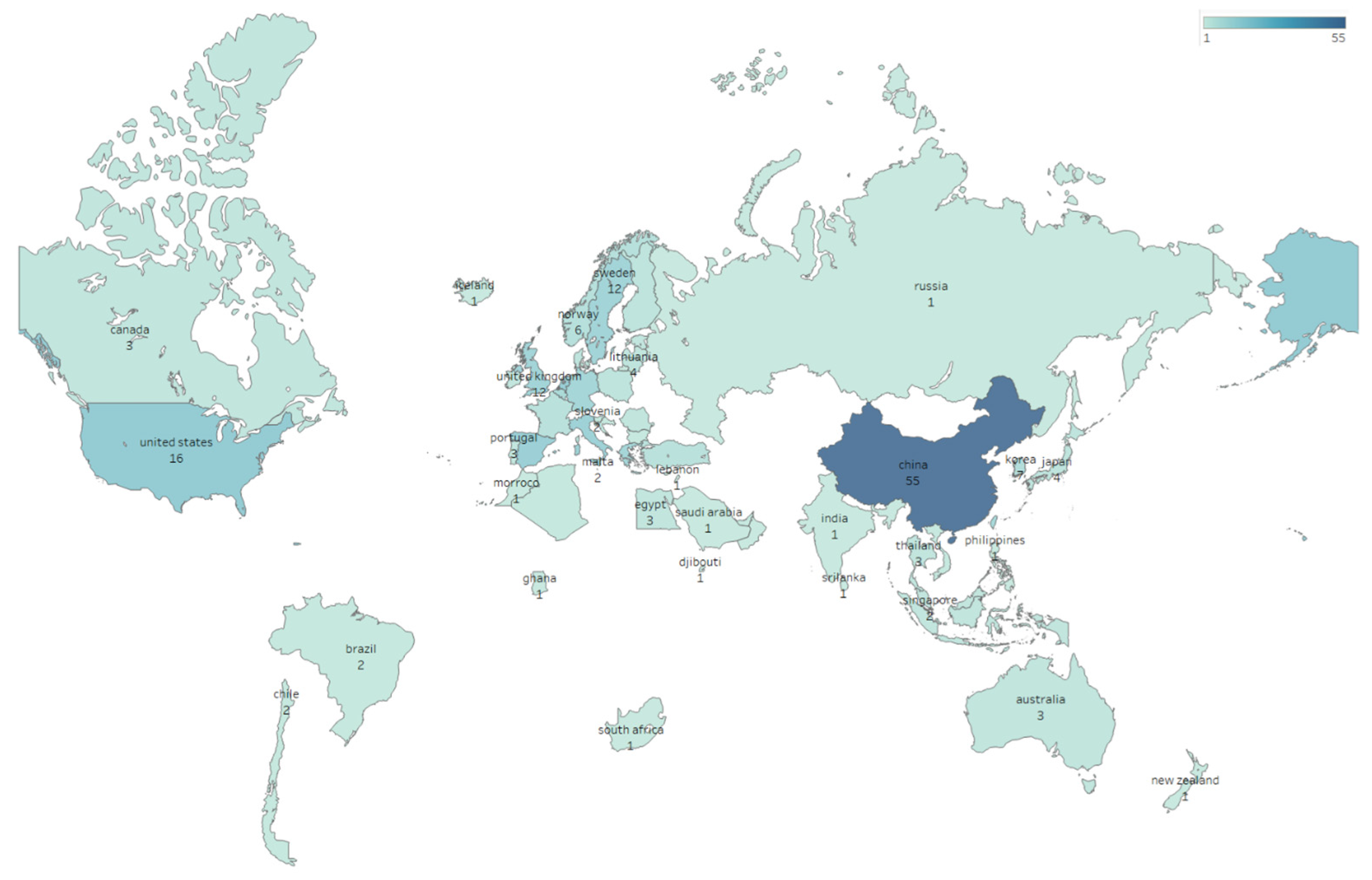
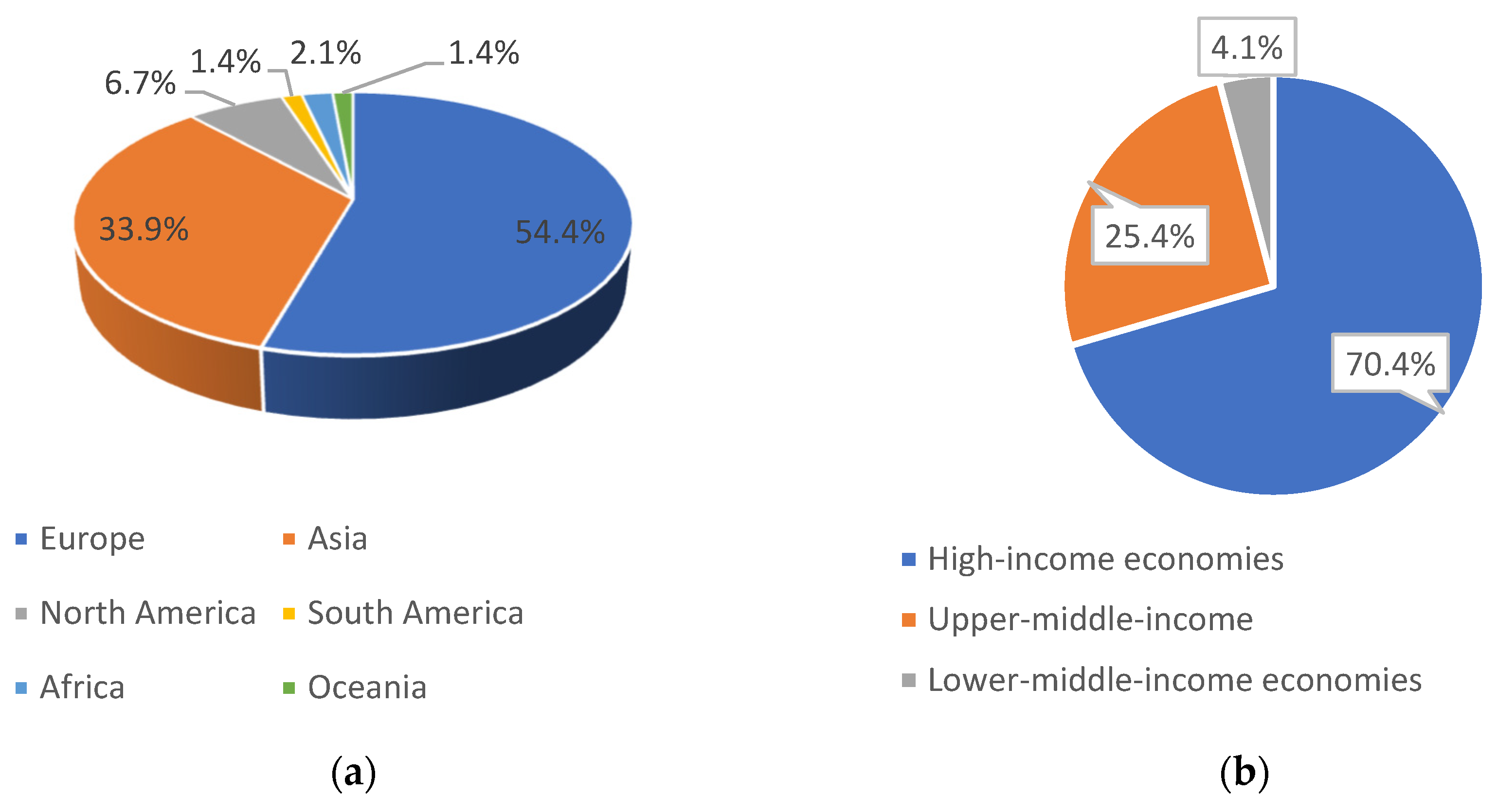
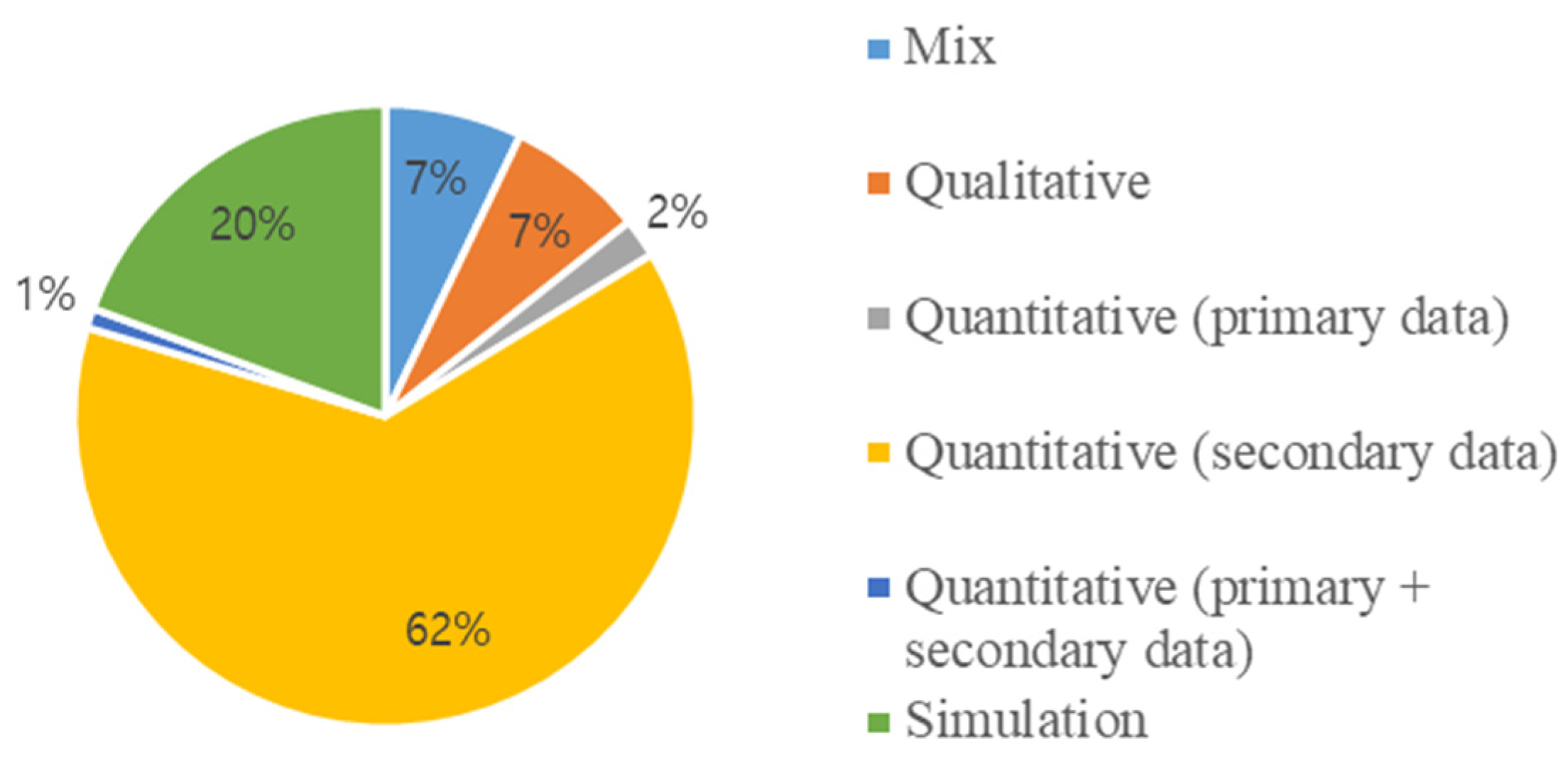
| Inclusion | Peer-reviewed articles that have strict methodologies and focus on CO2 reduction (decarbonisation) at ports from operation and management view. |
| Exclusion | Articles that did not thoroughly discuss the review topic on decarbonisation, such as articles of pure emission inventory, shipping decarbonisation, eco-efficiency assessment, etc. |
| Articles focused only on air pollutants such as black carbon, SOx, NOx. | |
| Measures as engine design and testing, construction engineering. | |
| Proceeding articles that share repetitive results in included articles. |
| Contributors | Number of Documents (Doc.) | Rank | Contributors | Number of Citations (Cit.) |
|---|---|---|---|---|
| China | 92 | 1 | China | 2910 |
| United States | 21 | 2 | United States | 1461 |
| United Kingdom | 17 | 3 | United Kingdom | 1001 |
| Sweden | 13 | 4 | Sweden | 769 |
| Taiwan | 12 | 5 | Taiwan | 645 |
| Italy | 11 | 6 | Australia | 630 |
| Spain | 11 | 7 | Greece | 552 |
| Australia | 9 | 8 | Spain | 543 |
| Greece | 9 | 9 | Denmark | 368 |
| The Netherlands/Germany | 8 | 10 | Germany | 350 |
| (a) | ||||||
| Author | Affiliation | Doc | Rank | Author | Affiliation | Cit. |
| Chen, Jihong | Shenzhen University, Shenzhen, China | 7 | 1 | Corbett, James J. | University of Delaware, USA | 612 |
| Wang, Wenyuan | Dalian University of Technology, China | 6 | 2 | Wang, Haifeng | Newark, USA | 532 |
| Peng, Yun | Dalian University of Technology, China | 4 | 3 | Winebrake, James J. | Rochester Institute of Technology, USA | 532 |
| Wang, Tingsong | Shanghai University, China | 4 | 4 | Chen, Jihong | Shenzhen University, China | 422 |
| Dai, Lei | Shanghai Jiao Tong University, Shanghai, China | 4 | 5 | Styhre, Linda | IVL Swedish Environmental Research Institute, Sweden | 373 |
| Hu, Hao | Shanghai Jiao Tong University, Shanghai, China | 4 | 6 | Winnes, Hulda | IVL Swedish Environmental Research Institute, Sweden | 373 |
| Diaz-ruiz-navamuel, Emma | University of Cantabria, Spain | 4 | 7 | Wang, Wenyuan | Dalian University of Technology, China | 272 |
| Zhen, Lu | Shanghai University, China | 4 | 8 | Giuliano, Genevieve | California State University, USA | 206 |
| Teng, Fei | Dalian Maritime University, China | 4 | 9 | O’brien, Thomas | University of Southern California, USA | 206 |
| Shan, Qihe | Dalian Maritime University, China | 4 | 10 | Chang, Ching-Chih | National Cheng Kung University, Taiwan | 201 |
| (b) | ||||||
| Author | Affiliation | Doc | Rank | Author | Affiliation | Cit. |
| Chen, Jihong | Shenzhen University, Shenzhen, China | 7 | 1 | Corbett, James J. | University of Delaware, USA | 612 |
| Olcer, Aykut | World Maritime University, Sweden | 7 | 2 | Wang, Haifeng | Newark, USA | 532 |
| Wang, Wenyuan | Dalian University of Technology, China | 6 | 3 | Winebrake, James J. | Rochester Institute of Technology, USA | 532 |
| Ballini, Fabio | World Maritime University, Sweden | 5 | 4 | Olcer, Aykut | World Maritime University, Sweden | 461 |
| Peng, Yun | Dalian University of Technology, China | 4 | 5 | Chen, Jihong | Shenzhen University, China | 422 |
| Alamoush, Anas S. | World Maritime University, Sweden | 4 | 6 | Iris, Çağatay | Nanyang Technological University, Singapore | 389 |
| Wang, Tingsong | Shanghai University, China | 4 | 7 | Lam, Jasmine Siu Lee | Nanyang Technological University, Singapore | 389 |
| Dai, Lei | Shanghai Jiao Tong University, Shanghai, China | 4 | 8 | Styhre, Linda | Ivl Swedish Environmental Research Institute, Sweden | 373 |
| Hu, Hao | Shanghai Jiao Tong University, Shanghai, China | 4 | 9 | Winnes, Hulda | Ivl Swedish Environmental Research Institute, Sweden | 373 |
| Islam, Samsul | Dalhousie University, Canada | 4 | 10 | Wang, Wenyuan | Dalian University of Technology, China | 272 |
| Journal | Doc. | Rank | Journal | Cit. |
|---|---|---|---|---|
| Sustainability | 26 | 1 | Transportation Research Part D: Transport and Environment | 2242 |
| Transportation Research Part D: Transport and Environment | 25 | 2 | Journal of Cleaner Production | 1097 |
| Journal of Cleaner Production | 22 | 3 | Sustainability | 492 |
| Ocean and Coastal Management | 9 | 4 | Energy Policy | 469 |
| Energies | 9 | 5 | Ocean and Coastal Management | 400 |
| Journal of Marine Science and Engineering | 9 | 6 | Research in Transportation Business and Management | 377 |
| Maritime Policy and Management | 7 | 7 | Transportation Research Part E: Logistics and Transportation Review | 366 |
| Computers and Industrial Engineering | 5 | 8 | Transportation Research Part A: Policy and Practice | 317 |
| Energy Policy | 4 | 9 | Maritime Policy and Management | 305 |
| Transportation Research Part E: Logistics and Transportation Review | 4 | 10 | Applied Energy | 225 |
Disclaimer/Publisher’s Note: The statements, opinions and data contained in all publications are solely those of the individual author(s) and contributor(s) and not of MDPI and/or the editor(s). MDPI and/or the editor(s) disclaim responsibility for any injury to people or property resulting from any ideas, methods, instructions or products referred to in the content. |
© 2025 by the authors. Licensee MDPI, Basel, Switzerland. This article is an open access article distributed under the terms and conditions of the Creative Commons Attribution (CC BY) license (https://creativecommons.org/licenses/by/4.0/).
Share and Cite
Minh, T.T.N.; Hoang, H.-T.H.; Nam, H.S.; Alamoush, A.S.; Duong, P.A. Revisiting Port Decarbonization for Advancing a Sustainable Maritime Industry: Insights from Bibliometric Review. Sustainability 2025, 17, 4302. https://doi.org/10.3390/su17104302
Minh TTN, Hoang H-TH, Nam HS, Alamoush AS, Duong PA. Revisiting Port Decarbonization for Advancing a Sustainable Maritime Industry: Insights from Bibliometric Review. Sustainability. 2025; 17(10):4302. https://doi.org/10.3390/su17104302
Chicago/Turabian StyleMinh, Tran Thi Nguyet, Hanh-Thi Hong Hoang, Hyung Sik Nam, Anas S. Alamoush, and Phan Anh Duong. 2025. "Revisiting Port Decarbonization for Advancing a Sustainable Maritime Industry: Insights from Bibliometric Review" Sustainability 17, no. 10: 4302. https://doi.org/10.3390/su17104302
APA StyleMinh, T. T. N., Hoang, H.-T. H., Nam, H. S., Alamoush, A. S., & Duong, P. A. (2025). Revisiting Port Decarbonization for Advancing a Sustainable Maritime Industry: Insights from Bibliometric Review. Sustainability, 17(10), 4302. https://doi.org/10.3390/su17104302









